

Essay Writing for Beginners: 6-Step Guide with Examples
If you need to write an essay, whether for a college course or to pass a writing test, this guide will take you through the process step-by-step.
Even if you have never written an essay before, this guide will make the process simple and easy to follow.
It is divided into two parts.
First, I’ll show you the steps of writing an essay from scratch using a simple example.
And in the second part, we’ll go through the process together and write a complete sample essay.
Let’s dive right in.
Writing an essay is a 6-step process.
Step 1. Decide on your main point and write it down
You could be in one of the following situations:
- Your teacher or professor gave you a prompt, and you have to follow it
- You are allowed to make up your own essay topic
- You must pass a writing test and are practicing
Whatever the case, let’s assume that you have some kind of a topic or an idea for an essay. Many essay prompts ask you to decide for or against an idea. You must agree or disagree.
And in your first step, you need to simply make that decision – whether you agree or disagree – and just write it down as a simple sentence.
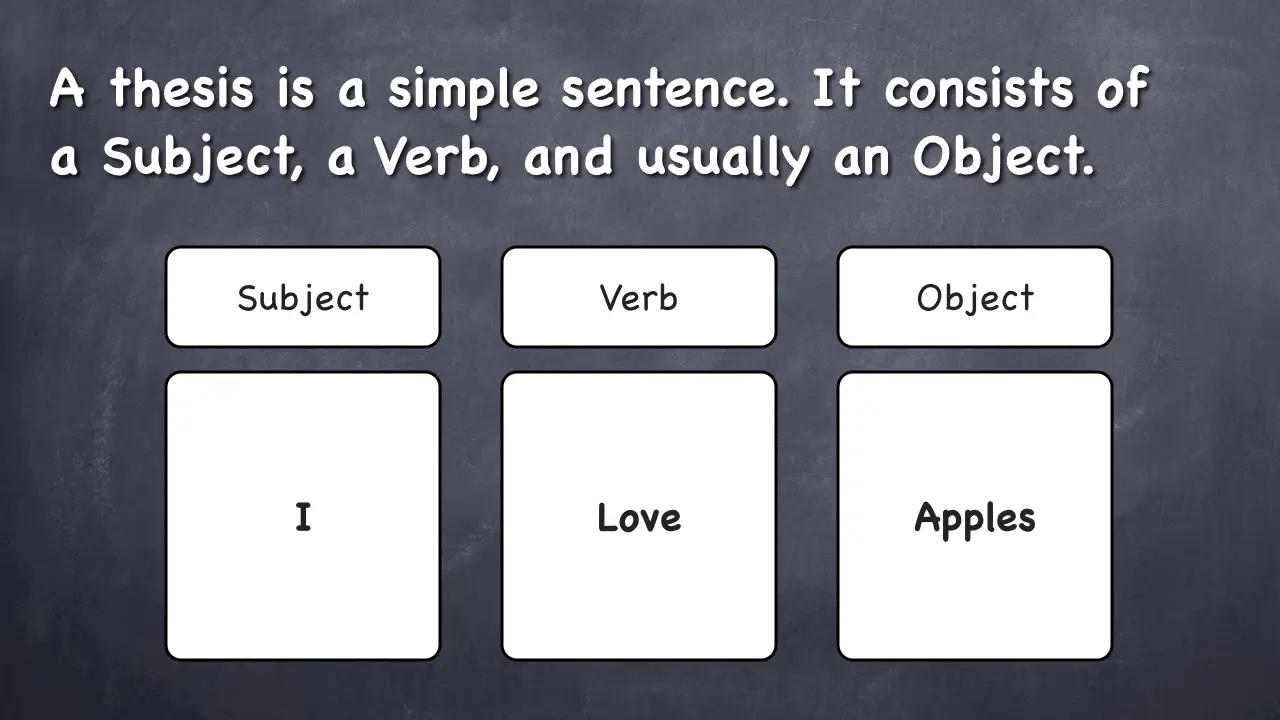
This is a very simple example, but it shows you what a thesis essentially looks like. It is also your main point.
Try not to make your thesis sentence too complicated. Keep it simple so that the point is perfectly clear to both you and the reader.
In this case, our example thesis is:
And we’re ready for the next step.
Step 2. Come up with three supporting ideas
Whether you need to write 300 or 3,000 words, as a beginner you only need three supporting points to prove your main point.
This is why I teach the Power of Three.
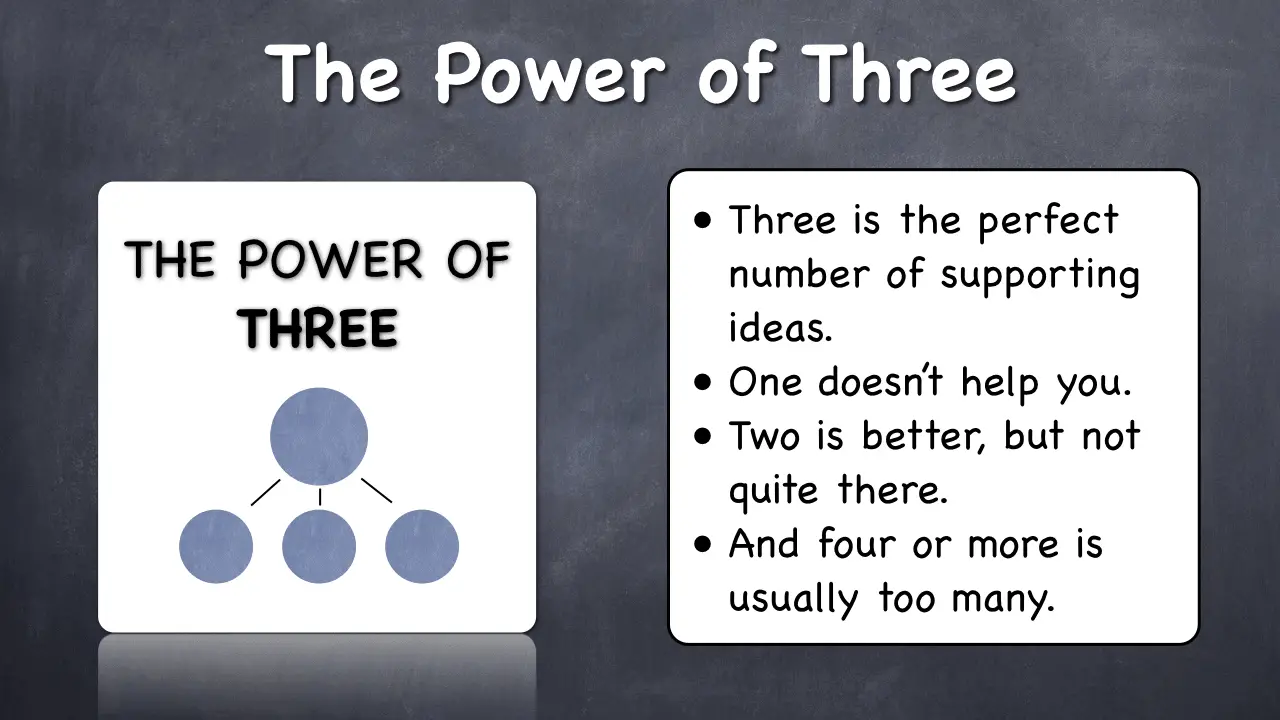
So, why three? You see, you need to divide your topic into subtopics. If you don’t, the whole essay writing process will be harder than it has to be.
If you divide it into only two parts, that’s okay. But it doesn’t give you enough meat when you’ll be writing the body of the essay.
If you divide it into more than three, that is also a recipe for frustration. It’s just too many.
Three is a very comfortable number for the brain to deal with. Trust me. I’ve taught many, many people.
Let’s apply the Power of Three to our simple example.
Why do I love apples? I love them for three reasons. Not one, not two, not seven. Just three reasons.
I love apples because they are:
- Nutritious
In this step, your job is to make sure that these three reasons are really different from one another. In this case, they are.
Here is a wrong way to do it:
In this case, apples being filling is too similar to being nutritious. This means that when you’re writing the body of the essay, you may run into writer’s block.
This happens because you realize that you’ve already said everything there is to say about the nutrition of apples, and now them being filling is too closely related. And you’re out of words to write.
Don’t let that happen. Just keep your supporting points really distinct from one another.
Step 3. Write out the complete thesis statement
Now you have everything you need to write a complete thesis statement. You have your main and supporting points.
Take them and write them out as complete sentences in one paragraph. Let’s do it very simplistically, using our apples example:
Again, this is overly simple, and I don’t expect you to write such short sentences one after another this way.
But it’s crystal clear. And the supporting points really sound like good evidence for the main point.
In other words, this thesis statement works.
Your Thesis Statement Is Also Your Outline
Students often ask how to write an essay outline. But once you have written your thesis statement the way I just showed you, you have yourself a nice outline.
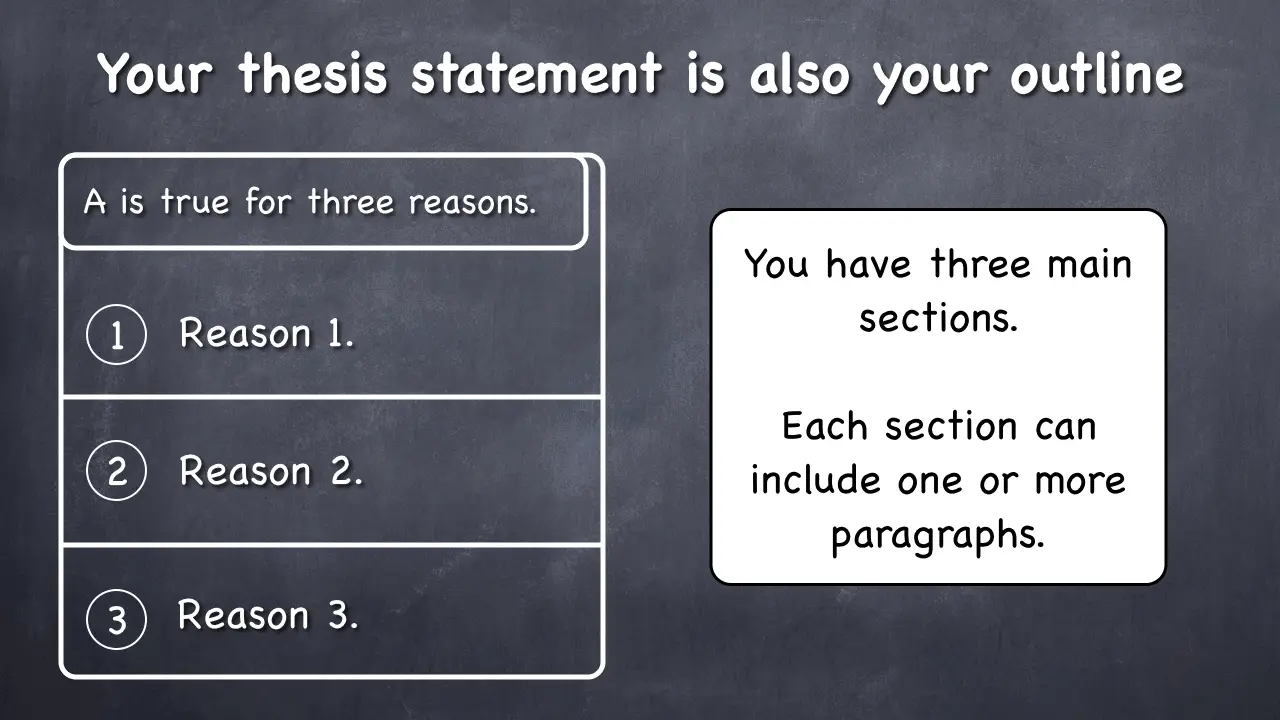
In addition, you already have the first paragraph. It may not be complete. You may choose to add some words to it. You will also add an introduction in a later step.
But your first paragraph is, for the main, done. It exists, and it’s good to know that you just wrote a nice paragraph.
We are ready for the next step.
Step 4. Write the body of the essay
We already know that we have three sections in our little example. And you will also have three main sections if you apply the Power of Three to your essay.
Each of your sections will contain one or more paragraphs.
But as a beginner, just stick to one paragraph per section. Each of your sections will be a paragraph, and you need to write only three paragraphs in the body of the essay.
Body Paragraph Structure
You must begin each of your body paragraphs with a lead sentence (also known as a topic sentence). And then your job is to fill the rest of the paragraph with evidence to support what you just stated in the lead sentence.
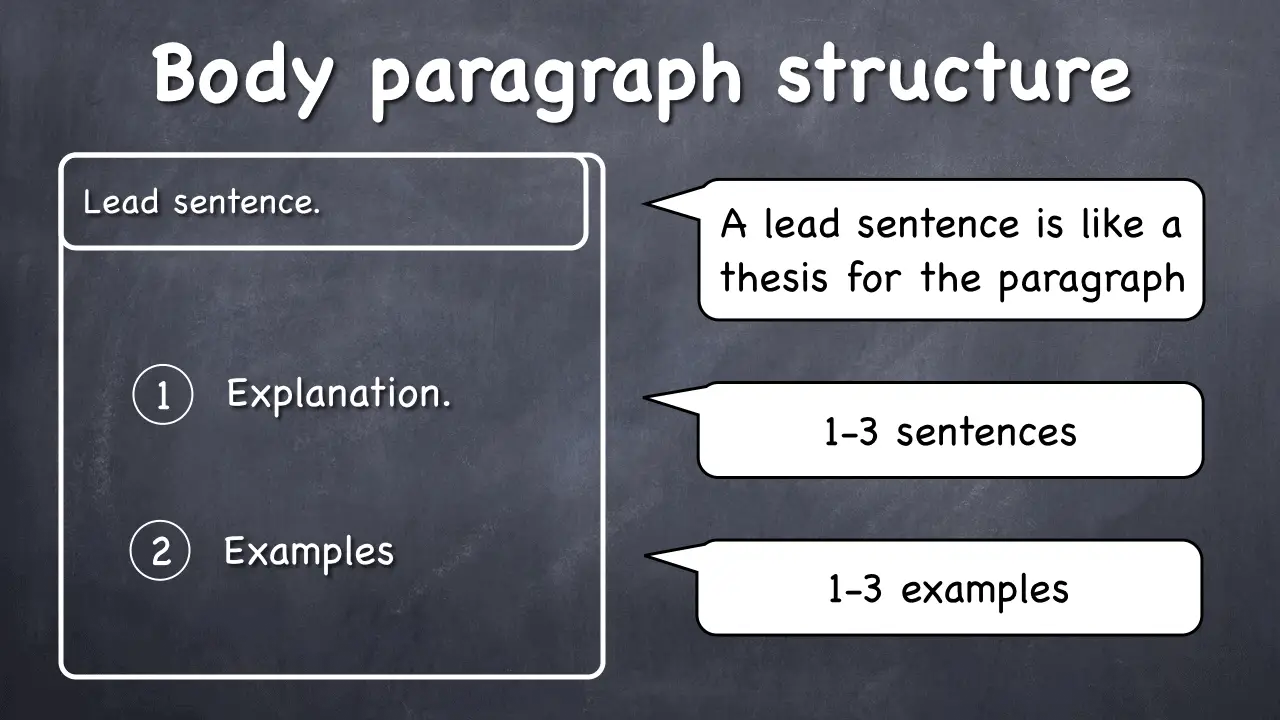
You may have heard that in your essay you should proceed from more general to more specific ? That is exactly right.
The lead sentence (the first sentence in the paragraph) is the most general statement in that paragraph.
For example, in our essay about apples, the second section is about how nutritious apples are. So, you would begin your paragraph with something like this:
This is the most general statement. And now, your job would be to unpack that, to write a little more specifically.
As an explanation , you can write a sentence or two on what kinds of nutrients apples contain.
And as examples , you can write about what some of these nutrients do in the body that makes them nutritious.
Does this make sense? You are proceeding from general to specific. We’ll take a closer look at this process in the essay topic sample that is coming up.
Once you’ve written the body paragraphs, you’re ready for the next step.
Step 5. Write the introduction and the conclusion
Introductions.
The introduction is really just a sentence (two at most) that you add in the beginning of your first paragraph.
Introductions are not necessary. Many instructors will expect that you write them while others won’t. You can go straight to the point by starting your first paragraph with the thesis.
However, most instructors will expect an introduction, and you should know how to write one.
To write an introduction, just zoom out a bit and write a more general and less relevant sentence. For example, we can start our essay about apples with this sentence:
And then we proceed straight to the thesis: “I love apples.” And so on…
Conclusions
In your conclusion you can do one of several things. But I recommend that, as a beginner, you stick to the time-proven restatement .
Basically, you simply repeat what you stated in your thesis statement, using different words.
Yes, this is repetitious, but that is the nature of conclusions. Don’t worry.
You can literally copy your thesis statement, paste it at the end of your essay, and make sure you change the wording so that it reads like a new paragraph.
For example, this is how we can write our conclusion about apples:
Yes, your conclusion can be just one sentence. But it can also contain many sentences.
Step 6. Proofread
Our final step in writing an essay is to go back and proofread our draft.
We must look out for:
- Any contradictions (to make sure we don’t contradict our own points)
- Any irrelevant material (stuff that doesn’t belong in the essay at all)
- Grammatical errors
- Misspellings
One good, thorough round of proofreading can be enough to be ready to submit your essay for grading.
You can use a variety of tools sto spell-check your essay. Google docs is one great tool for that. But many others, such as Grammarly, are available as well.
Guess what! Now you know how to write an essay, even if you’re a beginner.
And now, let’s apply what we learned.
Let’s take a sample topic and follow the 6 steps to write a nice sample essay.
Let’s do this!
Sample Essay: “Parents are the best teachers.”
This essay topic came from one of my readers. Let’s develop it into an essay by following the steps we just learned.
Step 1. Decide on the main point and write it
Let’s say that we are given a choice – whether we agree or disagree that parents are the best teachers.
All we have to do is take a stand. We have to simply decide – yes or no.
Let’s decide that parents are indeed the best teachers.
We simply state this as the main point:
Step 2. Think up three supporting ideas
Why could parents be the best teachers?
This will take some thinking. But that’s what we need to do.
Let’s use the Power of Three . And here is what we came up with:
- They are the first teachers, and that’s very important.
- They have the child’s best interests in mind.
- They spend more time with their child than anyone else.
We really want to make sure that these supporting points are different from one another. Are they?
If we read them over, we’ll see that each of them is indeed distinct. Great!
Step 3. Write out the thesis statement
We have our main point. We have our supporting points. And writing the full thesis statement is now easy.
Let’s do it:
We really just took the thesis and the supporting statements and wrote them all in a sequence as one paragraph.
As a result, we now have a nice, clear opening paragraph.
We also now have our outline:
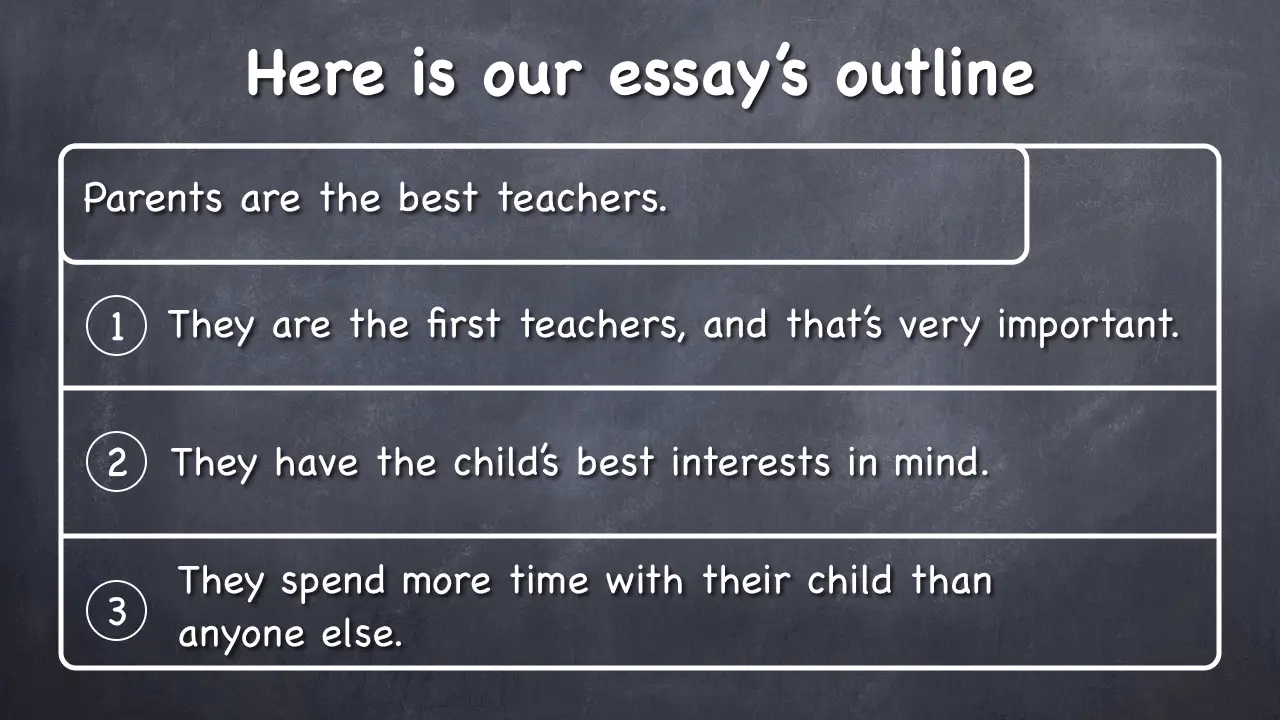
We know exactly how many sections our essay will have.
We also know in which order we’ll be presenting our support. It’s all in the thesis statement, which is also our outline.
Now our job is to write three good supporting paragraphs, one at a time.
Let’s start with the first body paragraph.
The first sentence is always the lead sentence – the most general sentence in a body paragraph.
Writing the Lead Sentence
Let’s first copy and paste our first supporting point from our thesis statement:
I copied this because this is exactly what my paragraph is about. And this would be a perfect lead sentence if it were not repetitious.
To make sure it’s not simply repetitious, we’ll tweak and expand it a little:
We made sure that the subject is clear – that it is not “ They ” but “ Parents .”
And we expanded the sentence by adding an explanation: “…because what is imprinted early stays with the child forever.”
You don’t have to necessarily add an explanation in the lead sentence like this. But this is an option that you have.
All we really want to do in the lead sentence is just expand it slightly over the initial supporting point that it came from.
Writing the Rest of the Paragraph
Let’s review our body paragraph structure:
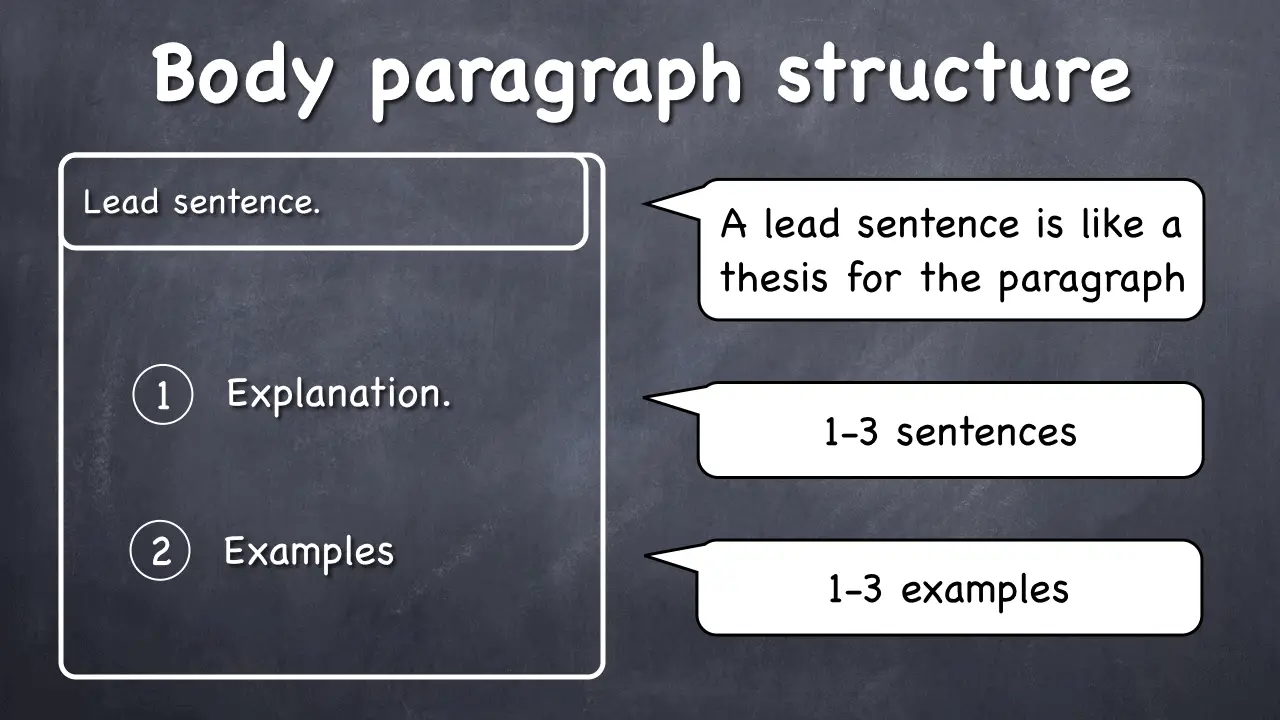
In our paragraph, we proceed from more general to more specific. Our lead sentence is the most general statement.
The next most general part of the paragraph is where you explain your point. You can provide a scientific explanation with data and research. You can explain it logically, using your own rationale.
But it is still a general part. Let’s write it.
Explanation
We are keeping it simple and not using any references to scientific studies. You can and should cite sources in your essay when necessary.
If you’re writing an essay in an exam or test, you won’t need any references. You can just make things up as you go along. And it works as long as your content is logical and supports the main point.
If you’re writing for a college course, you will likely need to cite sources, unless it’s English 101 where you write basic essays like this one.
But now, we have three explanatory sentences in our paragraph. Our next step is to add at least one example. You can add more, but one should do it for a beginner.
This example presents a phenomenon that is well known in psychology. It is an example because it describes one extreme kind of a phenomenon. It is also much more specific than our explanation.
Note that we can add more words by talking about a specific wild child from history. But let’s stop here and look at our full paragraph:
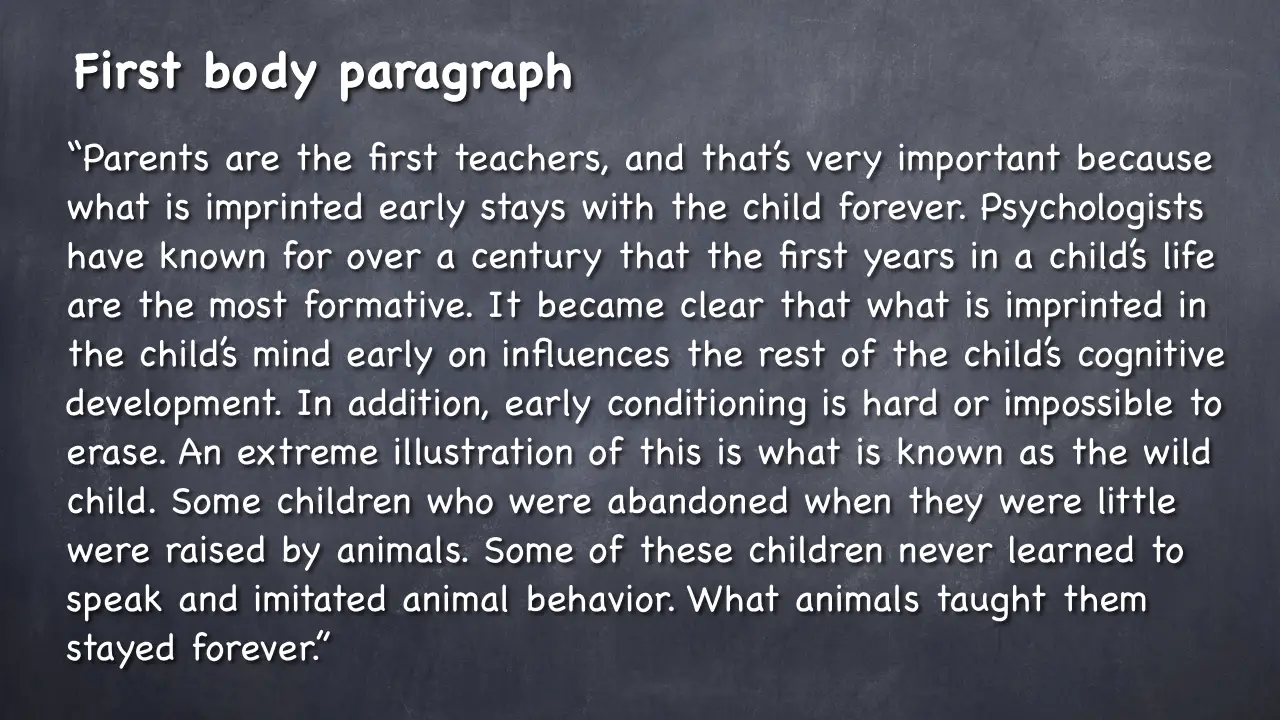
We have 113 words in this paragraph. And it’s a perfect body paragraph that supports the first part of our thesis statement.
Let’s write the next one.
Again, let’s copy the second supporting point and then tweak and expand it.
This sentence already starts with the subject, which is “ parents .” Now, all we need to do is to expand it slightly:
We added a short phrase just to make the lead sentence a little longer and more detailed. Now it doesn’t read like plain repetition.
Let’s write the next most general part of this paragraph – the explanation:
These three sentences explain why it makes sense that parents would have the child’s best interests in mind. She is the most precious thing to them in the world.
It’s time for an example. And I’ll use my personal experience:
It’s totally okay to use personal examples in an essay. You can use them even in advanced research papers. Your personal experience is valuable. Use it.
Let’s take a look at our second body paragraph in its entirety:
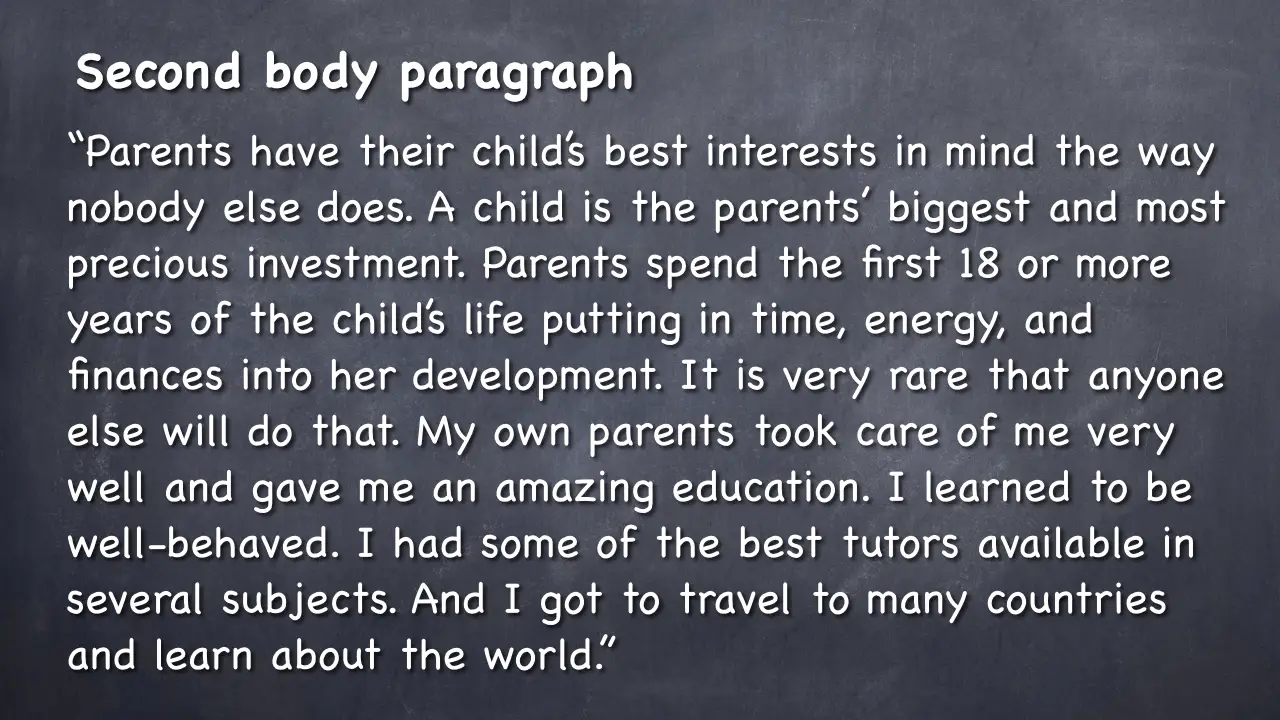
This paragraph contains 98 words of evidence to support the second point.
It’s time for the final body paragraph.
Again, you know what we’ll do. We’ll just copy our third supporting point and tweak and expand it a little:
Let’s make sure the reader knows what the real subject is in this sentence. And let’s also expand it just a bit:
Great! It’s time for the explanatory part:
Again, we won’t be citing any sources here and will keep it simple. This explanation works really well because it provides evidence for the third supporting point.
Let’s be even more specific and write at least one example.
Again, I’m using a personal example to show that whoever spends the most time with the child will have the most influence.
And let’s take a look at our third body paragraph as a whole:
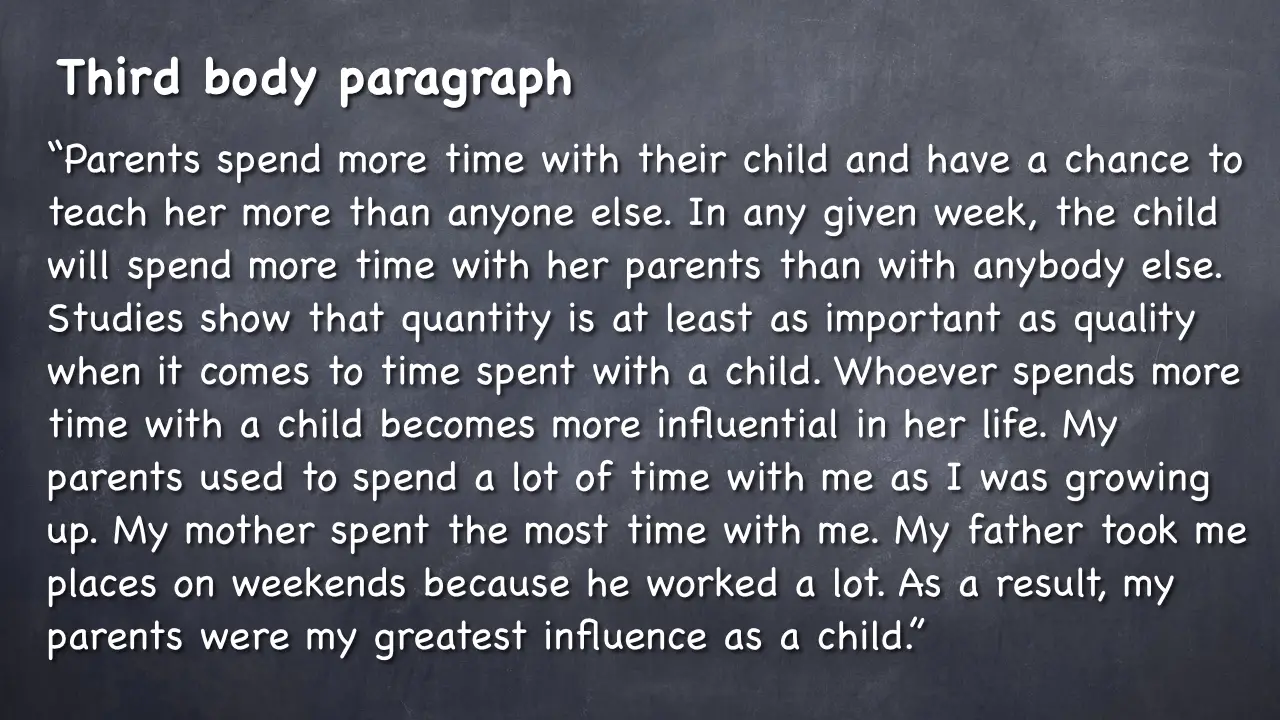
We have here 116 words of great, general-to-specific content that supports our third point.
As a result, if we look back at what we’ve done, we’ll see that everything we wrote in the body paragraphs supports the main point that parents are the best teachers.
It’s time for the next step.
Introduction
Our introduction will be just one sentence, which is enough.
First, let’s revisit our complete thesis statement. We will write the introductory sentence based on it.
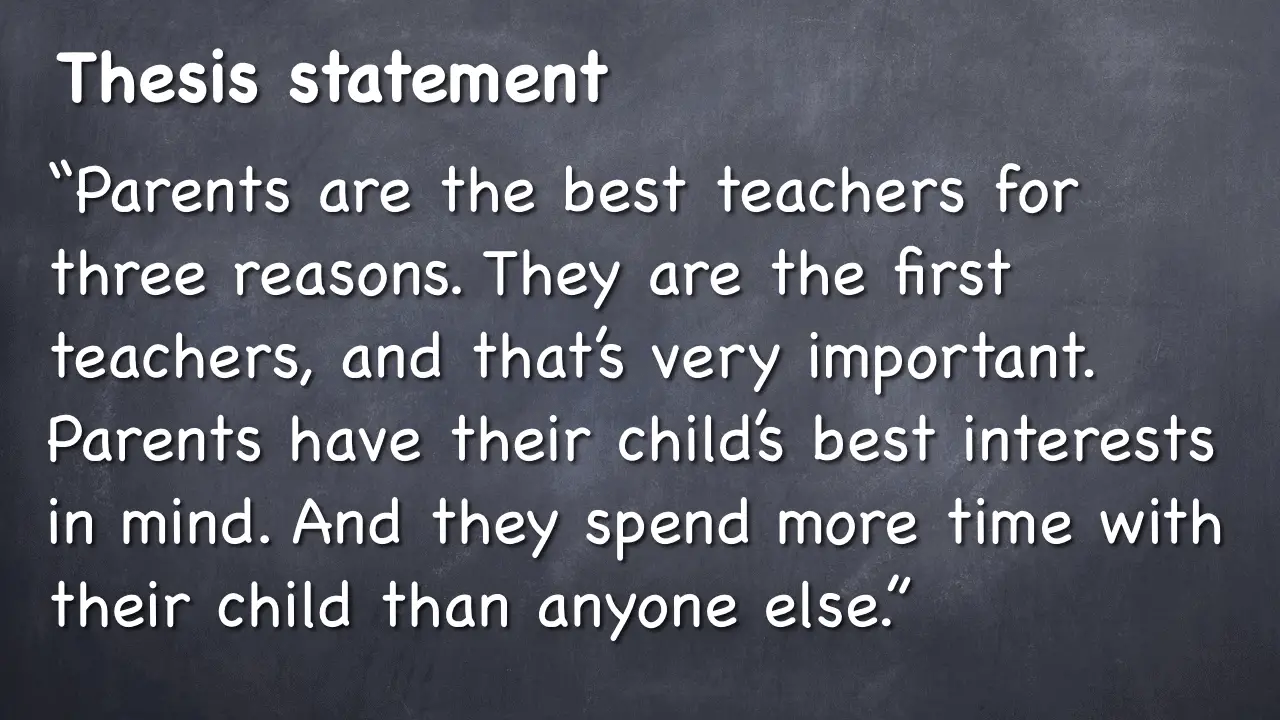
In this paragraph, we go straight to the point, and there’s nothing wrong with that.
However, as we know, most instructors will expect some kind of an introduction. So, we’ll add one sentence before we get to the main point.
This sentence must be more general. We are zooming out a little. Let’s do it:
And let’s take a look at the full paragraph together with the introduction:
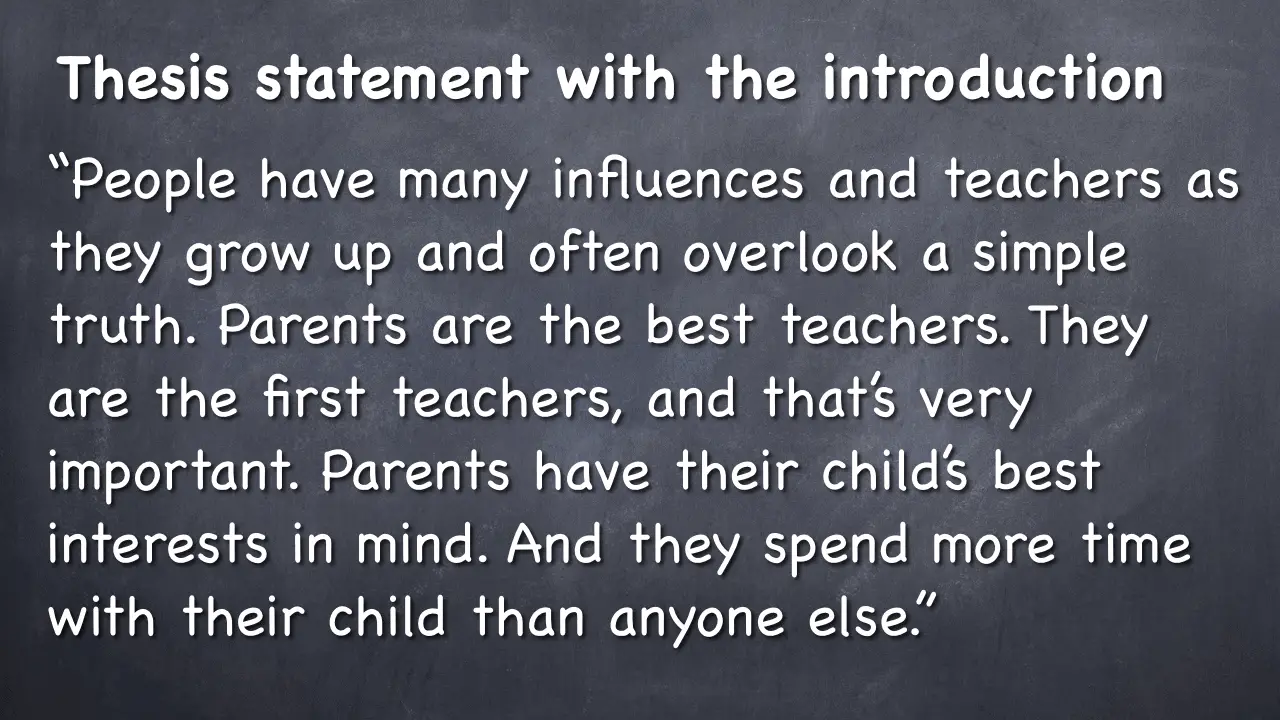
Note that I took out the phrase “for three reasons.” It is unnecessary because it is clear that you are providing three supporting points. And the whole paragraph sounds better this way.
To write the conclusion, we’ll simply reword the thesis statement. We only need to make sure that we don’t sound like we’re just repeating things.
That was not too hard, was it?
It’s time for the final step.
In this step, we just need to go over our essay, making final edits and corrections. And that’s all.
I hope this tutorial really helps you in your essay writing.
Stay tuned and we’ll talk soon!
How to Write a 300 Word Essay – Simple Tutorial
How to expand an essay – 4 tips to increase the word count, 10 solid essay writing tips to help you improve quickly, 6 simple ways to improve sentence structure in your essays.
Tutor Phil is an e-learning professional who helps adult learners finish their degrees by teaching them academic writing skills.
You Might Also Like...
How to Paraphrase in an Essay - Tutorial with Examples
https://youtu.be/1cCD66urqwo Paraphrasing is expressing the contents of a passage in different words. It allows the student to use other people’s content without copying or...
How to Expand an Essay - 4 Tips to Increase the Word Count
Do you feel that you’ve written all you could in this essay, but it’s still short of the word count requirement? Maybe you need to add a few hundred or even a thousand words. If so, you’ve...

Tips for Online Students , Tips for Students
How To Write An Essay: Beginner Tips And Tricks

Many students dread writing essays, but essay writing is an important skill to develop in high school, university, and even into your future career. By learning how to write an essay properly, the process can become more enjoyable and you’ll find you’re better able to organize and articulate your thoughts.
When writing an essay, it’s common to follow a specific pattern, no matter what the topic is. Once you’ve used the pattern a few times and you know how to structure an essay, it will become a lot more simple to apply your knowledge to every essay.
No matter which major you choose, you should know how to craft a good essay. Here, we’ll cover the basics of essay writing, along with some helpful tips to make the writing process go smoothly.

Photo by Laura Chouette on Unsplash
Types of Essays
Think of an essay as a discussion. There are many types of discussions you can have with someone else. You can be describing a story that happened to you, you might explain to them how to do something, or you might even argue about a certain topic.
When it comes to different types of essays, it follows a similar pattern. Like a friendly discussion, each type of essay will come with its own set of expectations or goals.
For example, when arguing with a friend, your goal is to convince them that you’re right. The same goes for an argumentative essay.
Here are a few of the main essay types you can expect to come across during your time in school:
Narrative Essay
This type of essay is almost like telling a story, not in the traditional sense with dialogue and characters, but as if you’re writing out an event or series of events to relay information to the reader.
Persuasive Essay
Here, your goal is to persuade the reader about your views on a specific topic.
Descriptive Essay
This is the kind of essay where you go into a lot more specific details describing a topic such as a place or an event.
Argumentative Essay
In this essay, you’re choosing a stance on a topic, usually controversial, and your goal is to present evidence that proves your point is correct.
Expository Essay
Your purpose with this type of essay is to tell the reader how to complete a specific process, often including a step-by-step guide or something similar.
Compare and Contrast Essay
You might have done this in school with two different books or characters, but the ultimate goal is to draw similarities and differences between any two given subjects.
The Main Stages of Essay Writing
When it comes to writing an essay, many students think the only stage is getting all your ideas down on paper and submitting your work. However, that’s not quite the case.
There are three main stages of writing an essay, each one with its own purpose. Of course, writing the essay itself is the most substantial part, but the other two stages are equally as important.
So, what are these three stages of essay writing? They are:
Preparation
Before you even write one word, it’s important to prepare the content and structure of your essay. If a topic wasn’t assigned to you, then the first thing you should do is settle on a topic. Next, you want to conduct your research on that topic and create a detailed outline based on your research. The preparation stage will make writing your essay that much easier since, with your outline and research, you should already have the skeleton of your essay.
Writing is the most time-consuming stage. In this stage, you will write out all your thoughts and ideas and craft your essay based on your outline. You’ll work on developing your ideas and fleshing them out throughout the introduction, body, and conclusion (more on these soon).
In the final stage, you’ll go over your essay and check for a few things. First, you’ll check if your essay is cohesive, if all the points make sense and are related to your topic, and that your facts are cited and backed up. You can also check for typos, grammar and punctuation mistakes, and formatting errors.
The Five-Paragraph Essay
We mentioned earlier that essay writing follows a specific structure, and for the most part in academic or college essays , the five-paragraph essay is the generally accepted structure you’ll be expected to use.
The five-paragraph essay is broken down into one introduction paragraph, three body paragraphs, and a closing paragraph. However, that doesn’t always mean that an essay is written strictly in five paragraphs, but rather that this structure can be used loosely and the three body paragraphs might become three sections instead.
Let’s take a closer look at each section and what it entails.
Introduction
As the name implies, the purpose of your introduction paragraph is to introduce your idea. A good introduction begins with a “hook,” something that grabs your reader’s attention and makes them excited to read more.
Another key tenant of an introduction is a thesis statement, which usually comes towards the end of the introduction itself. Your thesis statement should be a phrase that explains your argument, position, or central idea that you plan on developing throughout the essay.
You can also include a short outline of what to expect in your introduction, including bringing up brief points that you plan on explaining more later on in the body paragraphs.
Here is where most of your essay happens. The body paragraphs are where you develop your ideas and bring up all the points related to your main topic.
In general, you’re meant to have three body paragraphs, or sections, and each one should bring up a different point. Think of it as bringing up evidence. Each paragraph is a different piece of evidence, and when the three pieces are taken together, it backs up your main point — your thesis statement — really well.
That being said, you still want each body paragraph to be tied together in some way so that the essay flows. The points should be distinct enough, but they should relate to each other, and definitely to your thesis statement. Each body paragraph works to advance your point, so when crafting your essay, it’s important to keep this in mind so that you avoid going off-track or writing things that are off-topic.
Many students aren’t sure how to write a conclusion for an essay and tend to see their conclusion as an afterthought, but this section is just as important as the rest of your work.
You shouldn’t be presenting any new ideas in your conclusion, but you should summarize your main points and show how they back up your thesis statement.
Essentially, the conclusion is similar in structure and content to the introduction, but instead of introducing your essay, it should be wrapping up the main thoughts and presenting them to the reader as a singular closed argument.

Photo by AMIT RANJAN on Unsplash
Steps to Writing an Essay
Now that you have a better idea of an essay’s structure and all the elements that go into it, you might be wondering what the different steps are to actually write your essay.
Don’t worry, we’ve got you covered. Instead of going in blind, follow these steps on how to write your essay from start to finish.
Understand Your Assignment
When writing an essay for an assignment, the first critical step is to make sure you’ve read through your assignment carefully and understand it thoroughly. You want to check what type of essay is required, that you understand the topic, and that you pay attention to any formatting or structural requirements. You don’t want to lose marks just because you didn’t read the assignment carefully.
Research Your Topic
Once you understand your assignment, it’s time to do some research. In this step, you should start looking at different sources to get ideas for what points you want to bring up throughout your essay.
Search online or head to the library and get as many resources as possible. You don’t need to use them all, but it’s good to start with a lot and then narrow down your sources as you become more certain of your essay’s direction.
Start Brainstorming
After research comes the brainstorming. There are a lot of different ways to start the brainstorming process . Here are a few you might find helpful:
- Think about what you found during your research that interested you the most
- Jot down all your ideas, even if they’re not yet fully formed
- Create word clouds or maps for similar terms or ideas that come up so you can group them together based on their similarities
- Try freewriting to get all your ideas out before arranging them
Create a Thesis
This is often the most tricky part of the whole process since you want to create a thesis that’s strong and that you’re about to develop throughout the entire essay. Therefore, you want to choose a thesis statement that’s broad enough that you’ll have enough to say about it, but not so broad that you can’t be precise.
Write Your Outline
Armed with your research, brainstorming sessions, and your thesis statement, the next step is to write an outline.
In the outline, you’ll want to put your thesis statement at the beginning and start creating the basic skeleton of how you want your essay to look.
A good way to tackle an essay is to use topic sentences . A topic sentence is like a mini-thesis statement that is usually the first sentence of a new paragraph. This sentence introduces the main idea that will be detailed throughout the paragraph.
If you create an outline with the topic sentences for your body paragraphs and then a few points of what you want to discuss, you’ll already have a strong starting point when it comes time to sit down and write. This brings us to our next step…
Write a First Draft
The first time you write your entire essay doesn’t need to be perfect, but you do need to get everything on the page so that you’re able to then write a second draft or review it afterward.
Everyone’s writing process is different. Some students like to write their essay in the standard order of intro, body, and conclusion, while others prefer to start with the “meat” of the essay and tackle the body, and then fill in the other sections afterward.
Make sure your essay follows your outline and that everything relates to your thesis statement and your points are backed up by the research you did.
Revise, Edit, and Proofread
The revision process is one of the three main stages of writing an essay, yet many people skip this step thinking their work is done after the first draft is complete.
However, proofreading, reviewing, and making edits on your essay can spell the difference between a B paper and an A.
After writing the first draft, try and set your essay aside for a few hours or even a day or two, and then come back to it with fresh eyes to review it. You might find mistakes or inconsistencies you missed or better ways to formulate your arguments.
Add the Finishing Touches
Finally, you’ll want to make sure everything that’s required is in your essay. Review your assignment again and see if all the requirements are there, such as formatting rules, citations, quotes, etc.
Go over the order of your paragraphs and make sure everything makes sense, flows well, and uses the same writing style .
Once everything is checked and all the last touches are added, give your essay a final read through just to ensure it’s as you want it before handing it in.
A good way to do this is to read your essay out loud since you’ll be able to hear if there are any mistakes or inaccuracies.
Essay Writing Tips
With the steps outlined above, you should be able to craft a great essay. Still, there are some other handy tips we’d recommend just to ensure that the essay writing process goes as smoothly as possible.
- Start your essay early. This is the first tip for a reason. It’s one of the most important things you can do to write a good essay. If you start it the night before, then you won’t have enough time to research, brainstorm, and outline — and you surely won’t have enough time to review.
- Don’t try and write it in one sitting. It’s ok if you need to take breaks or write it over a few days. It’s better to write it in multiple sittings so that you have a fresh mind each time and you’re able to focus.
- Always keep the essay question in mind. If you’re given an assigned question, then you should always keep it handy when writing your essay to make sure you’re always working to answer the question.
- Use transitions between paragraphs. In order to improve the readability of your essay, try and make clear transitions between paragraphs. This means trying to relate the end of one paragraph to the beginning of the next one so the shift doesn’t seem random.
- Integrate your research thoughtfully. Add in citations or quotes from your research materials to back up your thesis and main points. This will show that you did the research and that your thesis is backed up by it.
Wrapping Up
Writing an essay doesn’t need to be daunting if you know how to approach it. Using our essay writing steps and tips, you’ll have better knowledge on how to write an essay and you’ll be able to apply it to your next assignment. Once you do this a few times, it will become more natural to you and the essay writing process will become quicker and easier.
If you still need assistance with your essay, check with a student advisor to see if they offer help with writing. At University of the People(UoPeople), we always want our students to succeed, so our student advisors are ready to help with writing skills when necessary.
Related Articles
The Complete Beginner's Guide to Academic Writing
#scribendiinc
Written by Scribendi
What Is Academic Writing?
Academic writing is a specialized form of writing that suits the particular needs of academic writers. Used effectively, it helps scholars express complex concepts, research, and theories clearly to their peers. Learning to embrace this style of writing is essential in academia. However, we all need to start somewhere.
Welcome, friend, to the beginner's guide to academic writing.
In this post, we'll cover the following topics:
Characteristics of Academic Writing
Major types of academic writing.
Finding Your Research Question & Thesis Statement
The Importance of a Strong Structure
Good Academic Writing Requires an Outline
Always Keep Your Writing Concise
Style Guides: Don't Wait until the Last Minute
Always edit and proofread your academic writing, parting advice, elevate your writing with professional editing.
Learn More OR Get Started
Throughout this guide, you'll see the words "academic writing" and "scholarly writing" being used interchangeably. Both of these terms refer to the same form of writing, and both adhere to the same set of characteristics.
Let's take a closer look at three of the major characteristics of academic writing.
1. Evidence Based
Unlike other forms of writing, academic writing prioritizes logical, evidence-based reasoning. Every conclusion or point that you make should be supported by evidence.
Furthermore, all of these points should work together to support your thesis. Your thesis is the topic or research question that your writing aims to investigate, discuss, prove, or disprove.
Scholarly writing should be formal in tone. This means no contractions, colloquialisms, or slang. It also means that your writing should avoid personal pronouns such as "I." In this style of writing, you should write in the third person.
Furthermore, while you're certainly encouraged to feel passionately about your topic, you should also aim to write in a neutral tone. This means that your writing should avoid inflammatory, judgment-call statements.
Instead, your writing should sound like a rational exploration of the facts and evidence that support your conclusions. Seek to eliminate bias from your writing and remember to thoughtfully engage with your opposition's viewpoints. Don't just dismiss them as "wrong."
3. Properly cited
Proper citations are one of the most important characteristics of academic writing. You should always support any evidence that you call on with clear, orderly citations and references. This not only lends authority to your writing but also helps others locate your sources and further expand on your topic.
Your citations and the overall formatting of your paper may change depending on your assigned style guide ( APA , the Chicago Manual of Style , or MLA , to name a few). Make sure to adhere to the specifications of your specific style guide.

Next, let's take a look at the major types of academic writing that you'll encounter. Unfortunately, part of the reason that the answer to "What is academic writing?" is so long is that the subject is littered with subcategories.
Below, we've listed some of the most common types of scholarly writing and linked them to articles detailing each one.
- Lab reports
- Book reports
- Theses and dissertations
- Grant proposals
- Literature reviews
These types of scholarly writing can be split into further subcategories. For example, an academic essay might fall into the descriptive, analytical, persuasive, or critical category—each of which might ask you to take a different approach in your writing.
Finding Your Research Question and Thesis Statement
Now that you have a grasp on what academic writing is, let's take a closer look at its elements. We'll begin with the star of the show, the thesis statement. However, in order to create your thesis statement, you'll first need a research question.
Select a topic that interests you and draft an intriguing question about it. That question is your research question. Make it as specific as possible, and as you dig into your research, continue to narrow its scope.
More often than not, the answers you find will become your thesis, which is the statement or question that your writing will investigate, prove, or disprove.
A good thesis statement should demonstrate the following characteristics:
- Evidence based
If you want to learn more about thesis statements, check out our article on how to write a great thesis statement .
The Importance of a Strong Structure
A good structure is vital in academic writing, and a clear, logical structure will help you present your ideas. Moreover, many forms of academic writing obey an established structure, which the reader will expect you to follow.
For example, many academic essays follow a five-part structure. It's okay to experiment with other structures from time to time, but it is a good one to start with.
A five-part structure involves an introduction, three body paragraphs, and a conclusion. Your introduction introduces your topic and situates its importance within your field. It establishes your methodology and introduces your thesis statement.
Your body paragraphs support your thesis in more detail. Each body paragraph begins with a topic sentence, after which a cycle of introducing subtopics, providing evidence, and reflecting on the impact of that evidence ensues.
Your conclusion should summarize your body paragraphs and reaffirm your thesis. It shouldn't contain any new information. Instead, think of it as an opportunity to finish strong and hammer in your points one last time.
Check out our Ultimate Essay Checklist for additional essay writing advice.
In order to have a strong structure, it's best to create an outline before you start writing. It'll help you keep yourself motivated and on track. It's much easier to write with a plan in mind than to write into a shapeless void.
If you can, leave time for multiple drafts. It may sound unnecessary; however, each draft will give you the time and mental space you need to drastically improve the quality of your writing.
Always Keep Your Writing Concise
Verbose writing is one of the most common issues in academic writing.
Whenever you can, keep things concise . Complex vocabulary and sentences are common in academic writing. However, they aren't everything. Learning to write concisely is a difficult skill to master. However, it has great benefits, including the ability to express yourself clearly.
To begin writing concisely, challenge yourself to first avoid the passive voice. It won't always be possible to use the active voice. However, favor the active voice whenever you can. It shakes up your writing, making it more dynamic and helping to propel the reader forward.

Style guides are intended to make your life easier, not complicate it. Think of them as friendly guides who will help you cite and format your work correctly. Don't wait until the last moment to crack yours open!
Here are three of the most common style guides and the fields they're commonly used in:
- The Chicago Manual of Style (Chicago), which is used in history, criminology, and business
- Modern Language Association (MLA) style, which is used in the humanities and liberal arts
- American Psychological Association (APA) style, which is used in the social sciences, psychology, business, and economics
Never underestimate the value of editing and proofreading your work. You wouldn't believe the number of errors that can be caught simply by taking a break, refreshing your mind, and settling in to complete an editing or proofreading pass.
In turn, professional editing and proofreading can give you an even stronger boost. When you work closely with a text, it's easy to skim over errors and confusing language. You already know how your writing should go, so it's easy for your brain to fill in the gaps.
You should now have all that you need to step out into the world of academic writing. It's time to take all that you've learned and put it into practice. Make your mark on the world. We'll be rooting for you.
Image source: Prostock-studio/elements.envato.com
Hire an Expert Academic Editor , or Get a Free Sample
About the author.

Scribendi's in-house editors work with writers from all over the globe to perfect their writing. They know that no piece of writing is complete without a professional edit, and they love to see a good piece of writing transformed into a great one. Scribendi's in-house editors are unrivaled in both experience and education, having collectively edited millions of words and obtained numerous degrees. They love consuming caffeinated beverages, reading books of various genres, and relaxing in quiet, dimly lit spaces.
Have You Read?
"The Complete Beginner's Guide to Academic Writing"
Related Posts

Online Research Tips for Students and Scholars: Our Most Helpful Articles

Quotation Marks: When to Use Single or Double Quotes

What is a Thesis?
Upload your file(s) so we can calculate your word count, or enter your word count manually.
We will also recommend a service based on the file(s) you upload.
English is not my first language. I need English editing and proofreading so that I sound like a native speaker.
I need to have my journal article, dissertation, or term paper edited and proofread, or I need help with an admissions essay or proposal.
I have a novel, manuscript, play, or ebook. I need editing, copy editing, proofreading, a critique of my work, or a query package.
I need editing and proofreading for my white papers, reports, manuals, press releases, marketing materials, and other business documents.
I need to have my essay, project, assignment, or term paper edited and proofread.
I want to sound professional and to get hired. I have a resume, letter, email, or personal document that I need to have edited and proofread.
Prices include your personal % discount.
Prices include % sales tax ( ).

Essay Writing Guide
Essay Writing
Last updated on: Jun 8, 2023
How to Write an Essay - A Complete Guide with Examples
By: Nova A.
13 min read
Reviewed By: Rylee W.
Published on: Jan 1, 2019

Are you finding yourself staring at a blank page, unsure of where to begin when it comes to writing an essay?
Do you struggle with organizing your thoughts and expressing your ideas effectively?
You're not alone!
Many students face challenges when it comes to essay writing, but fear not!
In this comprehensive guide, we will help you in writing impactful essays with confidence. From choosing a compelling topic to crafting a well-structured argument, we'll take you step-by-step through the essay writing process.
So, get ready to become a skilled essay writer in no time!

On this Page
Pre-Writing Process: Preparation and Planning
Building a strong foundation is key to crafting a stellar essay. The pre-writing process sets the stage for your essay by focusing on preparation and planning.
Understand the Essay Prompt or Topic
Before diving into the writing process, it is crucial to choose and thoroughly understand the essay topic .
Carefully read and analyze the requirements, instructions, and any specific guidelines provided.
Identify the key components of the prompt, such as:
- The main question or issue to be addressed
- The scope of the topic
- Any specific requirements for the essay
Choose the Type of Essay
The next step is to decide which type of essay you need to write. Choosing the correct type of essay is an important step toward your successful essay.
Here are the main types of essays in which every academic essay can be categorized.
- Descriptive Essay - A descriptive essay discusses the topic in detail so that it becomes easy to understand for the reader.
- Narrative Essay - A narrative essay is a narration of a story in the form of an essay.
- Persuasive Essay - A persuasive essay convinces the reader to accept your perspective about the essay topic.
- Expository Essay - An expository essay explains and clarifies the topic with great details and examples.
Knowing what type of essay you are required to write can help you choose the topic and draft the essay. Here are the other types of essays that you should also be familiar with.
- Argumentative essay
- Analytical essay
- Cause and effect essay
- Classification essay
- Synthesis essay
- Compare and Contrast Essay
Conduct Thorough Research
Once you have a clear understanding of the essay prompt, it's time to gather relevant information through research.
Utilize various sources such as scholarly articles and academic databases to gather information that will support your arguments.
Also decide what type of formatting and citation styles you need for your essay. Generally, the following are some common college essay writing styles for students:
- APA (American Psychological Association) - An Author-Date citation style designed for psychology and social science discipline.
- MLA (Modern Language Association) - An Author-Page number citation style designed for language and humanities disciplines.
- CMS (Chicago Manual of Style) - A Notes-bibliography or Author-Date citation style, also known as Turabian Style. It is applicable to both scientific and non-scientific disciplines.
Create an Outline to Structure Your Essay
An outline acts as a skeleton for your essay, providing a structured framework to guide your writing. It helps you with how to write essay format questions and ensure that your essay flows logically and coherently.
Start by organizing your main ideas or subtopics into sections or paragraphs. Then, under each main idea, list the supporting points, evidence, or examples you will include.
Wondering how to write an outline for an essay ? Here is a 5 paragraph essay outline structure.
Writing Process: Crafting Your Essay
The writing process includes engaging introduction, body and conclusion. Let’s get through the step by step for crafting each section.
Write the Introduction
An introduction paragraph is the first paragraph of your essay. The purpose of the introduction is to inform your reader about the topic that you will discuss in the essay.
If you are thinking how to write an essay introduction, here is what an engaging introduction includes:
Engaging Hook
To capture the reader's attention from the start, consider using a compelling hook .
This can be a thought-provoking question, a surprising fact, a relevant quote, or an intriguing anecdote.
The goal is to create curiosity and make the reader eager to continue reading.
Background Information
After grabbing the reader's attention, provide some context or background information related to your essay topic.
This will help the reader understand the significance and relevance of the subject matter.
It can include historical context, relevant statistics, or an overview of the current state of affairs.
Thesis Statement
Conclude the introduction with a clear and concise thesis statement that encapsulates the main argument or purpose of your essay.
The thesis statement should reflect the stance you will be taking and provide a roadmap for the subsequent body paragraphs.
Body Paragraphs
Body paragraphs are the linking paragraphs between the conclusion and introduction.
All the information, examples, facts, and details about the topic in this section ultimately support your thesis statement.
Topic Sentences and Supporting Arguments
In each body paragraph, start with a topic sentence that introduces the main point or argument.
Each topic sentence should be clear and specific, guiding the reader on what to expect in the paragraph.
Follow up with supporting arguments or ideas that expand on the topic sentence and provide evidence or examples to support your claims.
Using Evidence and Examples
To strengthen your arguments, include relevant evidence, examples, or data. This could be in the form of research findings, expert opinions, real-life scenarios, or personal experiences.
Ensure that the evidence directly supports your claims and helps convince the reader of your point of view.
Use Clear Transitions
Maintain a logical flow within and between paragraphs by using clear transitions.
Transitions help connect ideas and create a smooth transition from one point to another. This ensures that your essay is cohesive and easy to follow.
Use transition words and phrases such as "furthermore," "in addition," "on the other hand," and "in contrast" to signal shifts in ideas and create a seamless reading experience.
Conclusion
The conclusion is the last paragraph that summarizes the main theme of the essay and its outcomes. It should include:
Summarize Key Points
In the conclusion, provide a brief summary of the key points discussed in the body paragraphs. Remind the reader of the main arguments and evidence presented throughout the essay.
Restate the Thesis Statement
Reiterate the thesis statement but rephrase it or present it in a slightly different manner. This helps reinforce the central message and reminds the reader of the main focus of the essay.
Call-to-Action/ Impression
End the conclusion with a thought-provoking statement or a call to action. This could be a reflection on the broader implications of the topic, a suggestion for further research, or a call to action.
Post-Writing Process: Editing and Refining
After writing your essay, make sure you:
Proofread for Grammar and Spelling Errors
After completing the initial draft of your essay, it's crucial to thoroughly proofread it for any grammatical, spelling, or punctuation errors.
This step ensures that your writing is clear, polished, and professional.
Check for Clarity and Coherence
Read through your essay with a critical eye, examining the flow of ideas and the logical progression of arguments.
Ensure that each paragraph and sentence contributes to the overall coherence of the essay.
Look for any gaps in information or abrupt transitions and revise accordingly to enhance the clarity and readability of your essay.

Essay Checklist
Writing an essay requires careful attention to various aspects, ranging from content to structure, grammar, and formatting.
Use the following checklist to ensure that your essay meets the necessary requirements and is of high quality.
How to Write an Essay - Examples
There are several different categories of essays, each with its unique requirements. Each essay presents different information in different ways.
Here are some useful how-to-write essay samples for different types of essays that will help you write your essay.
HOW TO WRITE AN ACADEMIC ESSAY - EXAMPLE
HOW TO WRITE AN ARGUMENTATIVE ESSAY - EXAMPLE
HOW TO WRITE A NARRATIVE ESSAY - EXAMPLE
HOW TO WRITE A DESCRIPTIVE ESSAY - EXAMPLE
How to Write an Essay About Yourself
Tips for Effective Essay Writing
Writing an essay can be a challenging task, but with the right approach, you can create a compelling and well-crafted piece of work.
Here are some tips to help you improve your essay-writing skills:
- Understand the essay prompt: Carefully read and comprehend the essay prompt to ensure your essay stays focused.
- Plan and outline your essay: Create a clear outline to provide structure and coherence to your essay.
- Conduct thorough research: Gather reliable information from credible sources to support your arguments.
- Develop a strong thesis statement: Craft a clear and concise thesis statement that guides your writing.
- Write clear and concise paragraphs: Focus each paragraph on a single main idea and use concise language.
- Use evidence and examples: Support your claims with evidence, examples, and proper citations.
- Revise and edit: Review for clarity, coherence, grammar, and formatting errors.
- Seek feedback: Get input from others to gain valuable insights and suggestions for improvement.
- Practice writing regularly: Regular practice helps improve your writing skills and style.
- Manage your time: Take breaks and allocate time effectively for each stage of the writing process.
Common Mistakes to Avoid When Writing an Essay
As a beginner, there are high chance that you make mistakes while writing your essay. However, you can avoid them by working on some basics.
Below we have mentioned some common errors made by the non-natives.
- Using passive voice
- Adding complex sentences
- Adding improper or no transitional sentences
- Plagiarism
- Failing to follow the assignment instructions
- Ignoring pronoun subjective-objective agreement
- Improper or missing citation references
- Citing unreliable resources
You can also check this detailed video guide on what to avoid while writing an essay!
Make sure you avoid these mistakes to make your piece of writing impactful. However, if you are not sure about your essay writing skills, getting professional help is a good idea.
Let expert writers at 5StarEssays.com assist you with “ write my essay for me ” worries!
Get professional help with your essays and research papers to achieve academic success.
Contact us now to experience the difference our essay writing service can make. Don't wait, start writing exceptional essays today!
Frequently Asked Questions
How do i start writing an essay.
To start writing an essay, begin by understanding the essay prompt or topic. Conduct research to gather relevant information and develop a clear thesis statement. Create an outline to organize your thoughts and structure your essay.
What are the 5 parts of an essay?
The five parts of an essay include:
- Introduction
- Body Paragraphs
- Transitions
- References or Bibliography

Marketing, Literature
As a Digital Content Strategist, Nova Allison has eight years of experience in writing both technical and scientific content. With a focus on developing online content plans that engage audiences, Nova strives to write pieces that are not only informative but captivating as well.
Was This Blog Helpful?
Keep reading.
- The Art of Effective Writing: Thesis Statements Examples and Tips

- Writing a 500 Word Essay - Easy Guide

- What is a Topic Sentence - An Easy Guide with Writing Steps & Examples

- A Complete Essay Outline - Guidelines and Format

- 220 Best Transition Words for Essays

- Essay Format: Detailed Writing Tips & Examples

- How to Write a Conclusion - Examples & Tips

- Essay Topics: 100+ Best Essay Topics for your Guidance

- How to Title an Essay: A Step-by-Step Guide for Effective Titles

- How to Write a Perfect 1000 Word Essay

- How To Make An Essay Longer - Easy Guide For Beginners

- Learn How to Start an Essay Effectively with Easy Guidelines

- Types of Sentences With Examples

- Hook Examples: How to Start Your Essay Effectively

- Essay Writing Tips - Essential Do’s and Don’ts to Craft Better Essays

- How To Write A Thesis Statement - A Step by Step Guide

- Art Topics - 200+ Brilliant Ideas to Begin With

- Writing Conventions and Tips for College Students

People Also Read
- how to write a bio
- writing book report
- rhetorical analysis essay topics
- dissertation introduction
- analytical essay example
Burdened With Assignments?

Advertisement
- Homework Services: Essay Topics Generator
© 2024 - All rights reserved

- November 30, 2022
- Academic Advice
How To Write an Academic Essay: A Beginner’s Guide
UOTP Marketing

During college, you must participate in many writing assessments, one of the most important being academic essays. Unfortunately, only a few are well-informed about the process of academic writing.
If you’re reading this, you probably want to learn how to write an academic essay. Follow our guide! Here we’ll introduce the concept of the academic essay, the five components of an academic essay, the format of an academic essay, and more.
Ready to master your academic essay writing? Let’s go!
What Is an Academic Essay?
An academic essay is writing created to initiate debate, defend an idea, or present a new point of view by supporting it with evidence.
One of the most important components that differentiate it from typical essays you have written in high school is supporting ideas with evidence. If you claim that, for example, “divorces have a negative impact on young children,” you need to find sources that support your argument to make it more convincing.
Interpreting facts is another essential element of a successful academic piece of writing. Academic essays should be written in a formal tone, with a set structure, and have a critical, based, and objective viewpoint. You should be able to understand and transmit different points of view to your readers in a simple but formal manner.
Are you still trying to figure out what steps you should take to start writing? Keep scrolling!
How To Write an Academic Essay
Writing an academic essay can initially seem intimidating, especially if you are unfamiliar with the rules and requirements.
The time and effort spent on the writing task might differ depending on the topic, word limit, deadline, and other factors. However, the key steps, including preparing for the writing, creating a thesis statement, introduction, conclusion, and editing process, must be included in every academic writing style.
By following the detailed list of actions below, you can start and finish your essay in no time.
Prepare to write your essay
Before going into the technical part of the writing process, one piece of advice you should keep in mind is planning. Planning is as important as the writing process. If you plan correctly, you will have sufficient time to perform every step successfully. Failure to plan will lead to a messy essay and, worst-case scenario, an unfinished writing piece.
Understand your assignment
First and foremost, before you take any action regarding writing your essay, you must ensure you have clearly understood every tiny detail that your instructor has provided you—this step will determine your academic essay’s effectiveness. But why is that? Understanding the assignment in detail will leave no space for any irrelevant information that would lead to wasted time and, ultimately, a lower grade.
Develop your essay topic
If your instructor doesn’t give you a specific topic, you should spend some time finding a topic that fits the requirements. Finding a topic sounds easy, but finding the right one requires more than just a simple google search.
So, ensure you develop an original topic, as it adds more value to your academic writing. However, ensure that there is enough evidence from other sources to help you back up your arguments. You can do this by researching similar topics from trusted sources.
Do your research and take notes
Once you determine the topic, go on and do some research. This part takes a lot of effort since there are countless sources online, and obviously, you have to choose some of the best.
Depending on your topic, there might be cases where online sources are not available, and you’ll also have to visit local libraries. Whatever the case, you need to take notes and highlight the components you want to include in your essay.
A quick tip: Go back to your topic often to avoid getting swayed or influenced by other less relevant ideas.
Come up with a clear thesis statement
An excellent academic essay contains a strong thesis statement. A strong thesis statement successfully narrows your topic into a specific area of investigation. It should also intrigue your readers and initiate debate.
A good thesis statement is:
- NOT a question
- NOT a personal opinion
Create a structure
After gathering all the necessary information, you can begin outlining your main ideas. The primary academic essay structure is classified into the following
- Introduction
Failure to maintain these three components in your academic essay will result in a poorly written assignment. Luckily, you can easily avoid that by following our guide.
Writing the introduction

Your essay will be divided into paragraphs of equal importance, but the introductory part should always stand out. You must make your introduction as presentable as possible and get the reader’s attention. Work on it as if you were to get graded only by the evaluation of that first paragraph.
The purpose of the introduction is to demonstrate that your thoughts and ideas are logical and coherent. Also, depending on the word limit, you can use more than one paragraph.
Hook the reader
All forms of writing benefit from an attractive hook. If you have no idea of how to hook the reader, you can go the safe way and choose a recent fact or statistic. Statistics will give your essay credibility, surprise the readers, and make them want to keep reading.
Give background on the topic
Now that you have the reader’s attention, you should strive to expand the essay’s key points but to a limit since the introduction is only one part of the whole essay. You should generally explain what gaps from previous sources you will cover and what others have covered so far.
Interested in pursuing a degree?
Fill out the form and get all admission information you need regarding your chosen program.
This will only take a moment.
Message Received!
Thank you for reaching out to us. we will review your message and get right back to you within 24 hours. if there is an urgent matter and you need to speak to someone immediately you can call at the following phone number:.
By clicking the Send me more information button above, I represent that I am 18+ years of age, that I have read and agreed to the Terms & Conditions and Privacy Policy , and agree to receive email marketing and phone calls from UOTP. I understand that my consent is not required to apply for online degree enrollment. To speak with a representative without providing consent, please call +1 (202) 274-2300
- We value your privacy.
Present your thesis statement
When introducing your thesis statement, you can present it as a statement of fact or controversial. If you decide to give a statement fact, it will be challenging to keep your audience engaged since facts can be easily proven. But presenting it more controversially will keep your audience awake and can even result in a better grade overall.
Writing the body of your essay

The body part of your essay is where you’ll expand all of your ideas presented in the introduction. It’s essential to stay consistent and not include irrelevant information. Since it is the longest part of your essay, you can easily get lost, and to prevent that, it would be best to map an internal outline specific to each paragraph. This way, you know what to include and where.
Paragraph structure
Each paragraph should follow a specific structure. It should begin with an introductory sentence that tells the reader the main ideas you will discuss in the paragraph. It’s advisable to point back to your thesis statement to identify the relationship between it and the existing idea. Also, ensure that each paragraph demonstrates new ideas.
Length of the body paragraphs
Depending on the topic and the arguments you’ve gathered, it’s advisable not to exceed 200 words per paragraph in academic writing. If your paragraphs are too long and contain unnecessary wording, it will become difficult for the reader to follow your point. So keep them clear and concise.
Writing the conclusion
Congratulation, now you’ve made it to the last paragraph of your essay. The conclusion’s primary purpose is to summarize the ideas presented throughout your essay. Writing a good conclusion should take little time since you know what the essay contains. However, be aware of what points you should or shouldn’t include.
What to include in your conclusion
A strong conclusion needs to have an introductory sentence. In some cases, if your instructor approves, it can include other areas that need to be investigated in the future. But at its core, it should only remind the reader about the main arguments discussed.
What not to include in your conclusion
You should at all times refrain from including new ideas. Since the essay ends with the conclusion, don’t go into details or support new points. Doing that will confuse the reader and result in a poor grade.

Editing your essay

Without a doubt, editing is just as important as writing. No matter how careful you are during writing, there’s a high possibility that there will be some slip-ups. These can range from spelling mistakes to grammar, punctuation, and so on. We suggest you spend time doing other things and return to the essay again. This will help you notice errors that you otherwise wouldn’t.
Tips for Writing a Great College Essay
Now that you have a clear idea of the process of writing an academic essay, we have a few more tips:
- Always cite your sources
- Gather enough sources to support your thesis statement
- Keep your sentences short and comprehensive
- Start the research as early as possible
- Do not skip revising
The Bottom Line
Writing an academic essay is a complex task. But with the right tools, guidance, and willingness to learn from your mistakes, you will master academic writing in no time. Make sure to follow each of the abovementioned steps and practice as much as possible. And don’t forget to edit!
Share it with your friends!
Explore more.

Accounting vs. Finance Degree: Which Major to Choose?

12 Important Bookkeeping Skills You Need for a Successful Career
Recent resources.

What Is Scope In Project Management?

5 Phases of Project Management Explained

Master’s Degrees: The Best Paying Fields

COO vs CEO: Differences and Responsibilities
INTERESTED IN LEARNING MORE?
Chat with an Admissions Officer Now!

- Associates Degree
- Bachelors Degrees
- Masters Degrees
- Doctoral Degrees
- Faculty & Staff
- Accreditation
- Student Experience
QUICK LINKS
- Admission Requirements
- Military Students
- Financial Aid
Request More Information
100 Writing Practice Lessons & Exercises
by Joe Bunting | 50 comments
Want to become a better writer? Perhaps you want to write novels, or maybe you just want to get better grades in your essay writing assignments , or maybe you'd like to start a popular blog .
If you want to write better, you need practice. But what does a writing practice actually look like? In this post, I'm going to give you everything you need to kick off your writing practice and become a better writer faster.
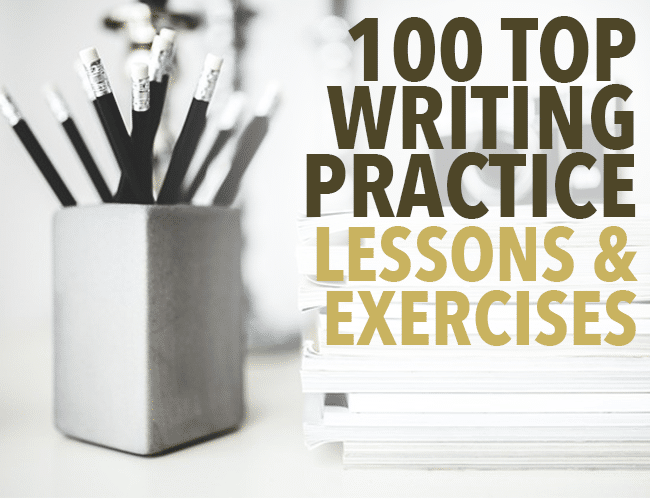
What Is Writing Practice?
Writing practice is a method of becoming a better writer that usually involves reading lessons about the writing process, using writing prompts, doing creative writing exercises , or finishing writing pieces, like essays, short stories , novels , or books . The best writing practice is deliberate, timed, and involves feedback.
How Do You Practice Writing?
This was the question I had when I first started The Write Practice in 2011. I knew how to practice a sport and how to practice playing an instrument. But for some reason, even after studying it in college, I wasn't sure how to practice writing.
I set out to create the best writing practice I could. The Write Practice is the result.
I found that the best writing practice has three aspects:
Deliberate . Writing whatever you feel like may be cathartic, but it's not an effective way to become a better writer or build your writing skills. You'll get better faster by practicing a specific technique or aspect of the writing process each time you sit down to write.
This is why we have a new lesson about the writing process each day on The Write Practice, followed by a practice prompt at the end so you can put what you learned to use immediately.
Timed . It's no secret writers struggle with focus. There are just too many interesting distractions—Facebook, email, Kim Kardashian's Instagram feed (just kidding about that last one, sort of)—and writing is just too hard sometimes.
Setting a timer, even for just fifteen minutes, is an easy and effective way to stay focused on what's important.
This is why in our writing practice prompt at the end of each post we have a time limit, usually with a link to an online tool egg timer , so you can focus on deliberate practice without getting distracted.
Feedback . Getting feedback is one of the requirements to deliberately practice writing or any other craft. Feedback can look like listening to the reactions of your readers or asking for constructive criticism from editors and other writers.
This is why we ask you to post your writing practice after each lesson, so that you can get feedback from other writers in The Write Practice community. It's also why we set up The Write Practice Pro community , to provide critique groups for writers to get feedback on each finished piece of writing.
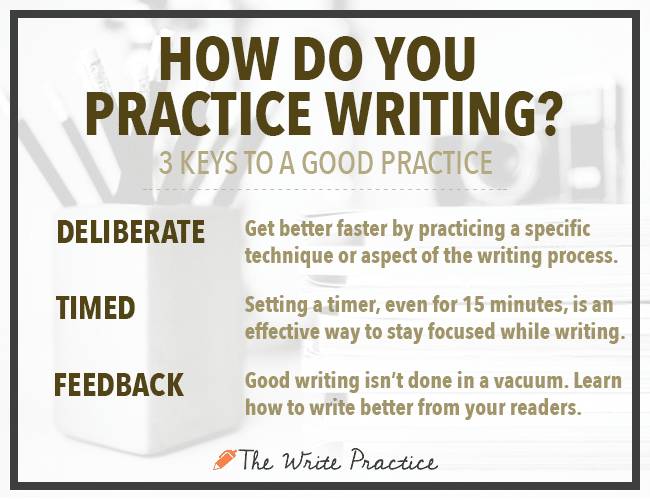
Our 100+ Best Creative Writing Practice Exercises and Lessons
Now that you know how we practice writing at The Write Practice, here are our best writing practice lessons to jumpstart your writing skills with some daily writing exercises, for beginner writers to even the most expert writers:
All-Time, Top 10 Writing Lessons and Exercises
These ten posts are our most viewed articles to boost your writing practice:
1. What is Plot? The 6 Elements of Plot and How to Use Them . Great stories use similar elements in wildly different ways to build page-turning stories. Click here to read what they are and learn how to start using them !
2. Top 100 Short Story Ideas . Here are over a hundred writing prompts in a variety of genres. If you need ideas for your next story, check this out!
3. How To Use Neither, Nor, Or, and Nor Correctly . Even good writers struggle figuring out when to use neither/nor and either/or. In this post, our copy-queen Liz Bureman settles the confusion once and for all. Click to continue to the writing exercise
4. Ten Secrets To Write Better Stories . How does Pixar manage to create such great stories, year after year? And how do you write a good story? In this post, I distill everything I've learned about how to write a good story into ten tips. Click to continue to the writing exercise
5. 35 Questions To Ask Your Characters From Marcel Proust . To get to know my characters better, I use a list of questions known as the Proust Questionnaire, made famous by French author, Marcel Proust. Click to continue to the writing exercise
6. How a Scene List Can Change Your Novel-Writing Life . Creating a scene list changed my novel-writing life, and doing the same will change yours too. Includes examples of the scene lists from famous authors. Click to continue to the writing exercise
7. Why You Need to be Using the Oxford Comma . Most people I've met have no idea what the Oxford comma is, but it's probably something that you have used frequently in your writing. Click to continue to the writing exercise
8. Six Surprising Ways to Write Better Interview Questions. The interview is the most-used tool in a journalist's bag. But that doesn't mean novelists, bloggers, and even students can't and don't interview people. Here's how to conduct a great interview. Click to continue to the writing exercise
9. Why You Should Try Writing in Second Person . You've probably used first person and third person point-of-view already. But what about second person? This post explains three reasons why you should try writing from this point-of-view. Click to continue to the writing exercise
10. The Secret to Show, Don't Tell . You've heard the classic writing rule, “Show. Don't Tell.” Every writing blog ever has talked about it, and for good reason. Showing, for some reason, is really difficult. Click to continue to the writing exercise.
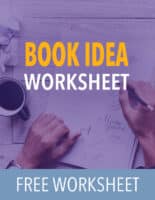
12 Exercises and Lessons To Become a Better Writer
How do you become a better writer? These posts share our best advice:
- Want to Be a Better Writer? Cut These 7 Words
- What I Mean When I Say I Am A Writer
- How to Become a Writer: 3 Simple Steps
- 72% of Writers Struggle With THIS
- 7 Lies About Becoming a Writer That You Probably Believe
- 10 Questions to Find Your Unique Writing Voice
- The Best Writing Book I’ve Ever Read
- The Best Way to Become a Better Writer
- The Creative Writer’s Toolkit: 6 Tools You Can’t Write Without
- Should You Write More or Write Better: Quantity vs Quality
- How to Become a Better Writer in One, Simple Step
- 11 Writing Tips That Will Change Your Life
6 Lessons and Exercises from Great Writers
If you want to be a writer, learn from the great writers who have gone before you:
- 23 Essential Quotes from Ernest Hemingway About Writing
- 29 Quotes that Explain How to Become a Better Writer
- 10 Lessons Dr. Seuss Can Teach Writers
- 10 Writing Tips from Ursula Le Guin
- Once Upon a Time: Pixar Prompt
- All the Pretty Words: Writing In the Style of Cormac McCarthy
12 Genre and Format Specific Writing Lessons and Exercises
Here are our best writing lessons for specific types of writing, including essays, screenplays, memoir, short stories, children's books, and humor writing:
- Writing an Essay? Here Are 10 Effective Tips
- How To Write a Screenplay: The 5 Step Process
- How to Write a Great Memoir: a Complete Guide
- How to Write a Short Story from Start to Finish
- How to Write a Thriller Novel
- How to Write a Children's Book
- How to Write a Love Story
- How to Write a Coming of Age Story or Book
- How to Write an Adventure Book
- 5 Key Elements for Successful Short Stories
- 4 Tips to Write a Novel That Will Be Adapted Into a Movie
- Humor Writing for People Who Aren’t Funny
14 Characterization Lessons and Exercises
Good characters are the foundation of good fiction. Here are our best lessons to create better characters:
- Character Development: How to Create Characters Audiences Will Love
- Writing Villains: 9 Evil Examples of the Villain Archetype
- How NOT to Introduce a New Character
- The Strongest Form of Characterization
- The Most Important Character Archetype
- How Do You Build A Strong Character In Your Writing?
- 75+ Antihero Examples and How to Use Them
- How to Explore Your Characters’ Motivations
- 8 Tips for Naming Characters
- The Protagonist: How to Center Your Story
- Heroes vs. Anti-Heroes: Which Is Right For Your Story?
- The Weakest Form of Characterization
- How to Write With an Accent
- How To Create a Character Sketch Using Scrivener
15 Grammar Lessons and Exercises
I talk to so many writers, some of whom are published authors, who struggle with grammar. Here are our best writing lessons on grammar:
- Is It Okay To End A Sentence With A Preposition?
- Contractions List: When To Use and When To Avoid
- Good vs. Well
- Connotation vs. Denotation
- Per Se vs. Per Say
- When You SHOULD Use Passive Voice
- When Do You Use “Quotation Marks”
- Polysyndeton and Asyndeton: Definition and Examples
- The Case Against Twilight
- Affect Versus Effect
- Stop Saying “Literally”
- What Is a Comma Splice? And Why Do Editors Hate Them?
- Intra vs. Inter: Why No One Plays Intermural Sports
- Alright and Alot: Words That Are Not Words
- The Poor, Misunderstood Semicolon
4 Journalism Lessons and Exercises
Want to be a journalist? Or even use techniques from journalism to improve your novel, essay, or screenplay? Here are our best writing lessons on journalism:
- Six Ways to Ask Better Questions In Interviews
- How Should You Interview Someone? Over Email? In Person?
- What If They Don’t Want to Talk to You?
- Eleven Habits of a Highly Effective Interviewers
16 Plot and Structure Lessons and Exercises
Want to write a good story? Our top plot and structure lessons will help:
- The Ten Types of Story and How to Master Them
- Points of a Story: 6 Plot Points Every Story Needs
- How to Shape a Story: The 6 Arcs
- 7 Keys To Write the Perfect First Line of a Novel
- The Secret to Creating Conflict
- 4 Tips to Avoid Having Your Short Story Rejected by a Literary Magazine
- 7 Steps to Creating Suspense
- 5 Elements of Storytelling
- 3 Important Rules for Writing Endings
- A Writer’s Cheatsheet to Plot and Structure
- Overcoming the Monster
- How to Satisfy Your Reader With a Great Ending
- Pow! Boom! Ka-Pow! 5 Tips to Write Fight Scenes
- The Dramatic Question and Suspense in Fiction
- How to Write a Memorable Beginning and Ending
- How to Write the Perfect First Page
6 Lessons and Exercises to Beat Writer's Block
Writer's block is real, and it can completely derail your writing. Here are six lessons to get writing again:
- How To Write Whether You Feel Like it Or Not
- This Fun Creative Writing Exercise Will Change Your Life
- When You Should Be Writing But Can't…
- What to do When Your Word Count is Too Low
- 7 Tricks to Write More with Less Willpower
- When You Don’t Know What to Write, Write About Your Insecurities
7 Literary Technique Lessons and Exercises
These writing and storytelling techniques will teach you a few tricks of the trade you may not have discovered before:
- 3 Tips to “Show, Don’t Tell” Emotions and Moods
- 3 Reasons to Write Stream of Consciousness Narrative
- 16 Observations About Real Dialogue
- Intertextuality As A Literary Device
- Why You Should Use Symbolism In Your Writing
- 6 Ways to Evoke Emotion in Poetry and Prose
- 3 Tips To Write Modern Allegorical Novels
- Symbol vs. Motif: What’s the Difference
3 Inspirational Writing Lessons and Exercises
Need some inspiration? Here are three of our most inspiring posts:
- Why We Write: Four Reasons
- You Must Remember Every Scar
- 17 Reasons to Write Something NOW
3 Publishing Blogging Lessons and Exercises
If you want to get published, these three lessons will help:
- The Secret to Writing On Your Blog Every Day
- How to Publish Your Book and Sell Your First 1,000 Copies
- How to Get Published in Literary Magazines
11 Writing Prompts
Need inspiration or just a kick in the pants to write. Try one of our top writing prompts :
- Grandfathers [writing prompt]
- Out of Place [writing prompt]
- Sleepless [writing prompt]
- Longing [writing prompt]
- Write About Yourself [writing prompt]
- 3 Reasons You Should Write Ghost Stories
- Road Trip [writing prompt]
- Morning [writing prompt]
- The Beach [writing prompt]
- Fall [writing prompt]
- How to Use Six-Word Stories As Writing Prompts
Is It Time To Begin Your Writing Practice?
It's clear that if you want to become a writer, you need to practice writing. We've created a proven process to practice your writing at The Write Practice, but even if you don't join our community, I hope you'll start practicing in some way today.
Personally, I waited far too long to start practicing and it set my writing back years.
How about you? Do you think practicing writing is important? Let me know in the comments section .
Choose one of the writing practice posts above. Then, read the lesson and participate in the writing exercise, posting your work in the Pro Practice Workshop . And if you post, please give feedback to your fellow writers who also posted their practices.
Have fun and happy practicing!
Joe Bunting
Joe Bunting is an author and the leader of The Write Practice community. He is also the author of the new book Crowdsourcing Paris , a real life adventure story set in France. It was a #1 New Release on Amazon. Follow him on Instagram (@jhbunting).
Want best-seller coaching? Book Joe here.

Join over 450,000 readers who are saying YES to practice. You’ll also get a free copy of our eBook 14 Prompts :
Popular Resources
Book Writing Tips & Guides Creativity & Inspiration Tips Writing Prompts Grammar & Vocab Resources Best Book Writing Software ProWritingAid Review Writing Teacher Resources Publisher Rocket Review Scrivener Review Gifts for Writers
Books By Our Writers

Now, Take Your Idea and Write a Book!
Enter your email to get a free 3-step worksheet and start writing your book in just a few minutes.
You've got it! Just us where to send your guide.
Enter your email to get our free 10-step guide to becoming a writer.
You've got it! Just us where to send your book.
Enter your first name and email to get our free book, 14 Prompts.
- AI Content Shield
- AI KW Research
- AI Assistant
- SEO Optimizer
- AI KW Clustering
- Customer reviews
- The NLO Revolution
- Press Center
- Help Center
- Content Resources
- Facebook Group
How to Write an Essay for Beginners: Effective Guide
Table of Contents
Writing essays is not something that everyone enjoys. But essay writing is a key skill useful in high school, college, and even employment. Therefore, learning how to write an essay for beginners and pouring your thoughts into a piece of paper should not be understated.
Having a stress-free writing process starts with reviewing the basics and following a common pattern. This article will guide you through the steps to craft a good and effective essay.
The Primary Stages of Essay Writing
Putting all your ideas of the subject matter immediately on the paper is not the right approach to start writing an essay. Many students make the mistake of writing their essays without properly understanding the key stages.
Essay writing involves three important stages, each with its distinct purpose. While the actual essay writing is the most significant component, the other two stages are equally crucial.
Here are the primary stages of essay writing:
Preparation
Before you start writing anything on paper, the first step is to plan out your content and outline the structure of your essay. Define your essay topic and make sure the subject is something you know a little about or are interested in. Come up with an appropriate thesis statement which is the central argument you want to make in your essay.
Then research the topic and write a thorough outline based on your findings. With proper research and outline, your essay should have a framework to build upon . Keep in mind that the preparation stage will always make your writing process much easier.
The actual writing process of the essay is the most time-consuming part. At this stage, you’ll structure your essay and write down all your thoughts, ideas, and opinions on paper. You’ll focus on refining and expanding your thoughts throughout the introduction, body paragraphs, and conclusion.
The final stage of your essay writing is revision. You will review your essay one last time and make a few last corrections if needed. Check your essay for its coherence, and make sure of the logic and relevance of each point. You must cite your references and properly back up your fact with supporting details. Additionally, you can look for formatting, grammatical, and punctuation issues.

How to Write an Essay for Beginners
You can break down an essay into five sections: one introduction, three body paragraphs, and one conclusion. However, it’s not a strict structure but a generally accepted one.
If you’re a beginner in the essay writing process, it’s good to stick to the traditional structure and understand what each section entails. Let’s look at each section of essay writing in detail.
Introduction
As the name suggests, your introduction paragraph aims to introduce your topic. A strong introduction must start with a hook or anything that draws the reader in and piques their interest.
One of the crucial elements of the introduction is the thesis statement which typically appears toward the end of the introduction. The thesis statement is a phrase that highlights the argument, viewpoint, and main idea that you want to develop throughout the essay.
Throughout your introduction, include a brief summary of what to expect and mention a few points you’ll expand on in the body paragraphs.
Body Paragraphs
The body paragraphs hold the most weight of your essay. You should develop your ideas and discuss every issue related to your main topic in the body paragraphs.
Generally, your essay should contain three body paragraphs, with each one addressing a unique issue or idea. You can consider each of these sections as evidence. When these paragraphs are combined, they serve as supporting points to fully back up your thesis statement.
But make sure each of the body paragraphs is connected in some way so that the essay flows. The points should be sufficiently distinct, but they also need to be related to one another and unquestionably to your thesis statement.
It’s crucial to bear in mind that each body paragraph advances your point to prevent wandering off-topic or writing irrelevant information.
Many students struggle with how to conclude an essay and often rush through it or keep it aside. But this part of your writing is just as crucial as the rest of the essay.
In your conclusion, you shouldn’t introduce any new concepts; instead, you should restate your primary arguments and demonstrate how they support your thesis statement.
The conclusion is essentially the same as the introduction in terms of structure and substance. But instead of introducing your essay, it should summarize the key points and close the argument of your essay.
Wrapping Up
While essays may seem simple, a lot goes into them, so it takes time and effort to work on one. Despite this, the result is worth it for many people for a number of reasons.
Essay writing is a crucial skill required in many aspects of your academic and professional career. If you’re just a beginner or someone who needs to polish the basics of essay writing, this article can help you!

Abir Ghenaiet
Abir is a data analyst and researcher. Among her interests are artificial intelligence, machine learning, and natural language processing. As a humanitarian and educator, she actively supports women in tech and promotes diversity.
Explore All Essay Outline Tool Articles
How to write a synthesis essay outline.
One of the most interesting assignments you could have is writing a synthesis essay. For a college or university student,…
- Essay Outline Tool
Learning the Structure of an Informational Essay
Academic writing assignments, primarily essays, are required of all college and university students. That’s because they think it will aid…
The Correct Way to Structure an Article
Writing non-fiction has a set format that can be followed, which makes it not all that different from writing fiction.…
Exploring the Structure of a Response Essay
You will typically be expected to write in a formal and impersonal voice when you are given the assignment of…
Writing a Persuasive Essay? Use This Structure!
Writing essays is a requirement of your academic program as a college student. Whether you love them or loathe them,…
Writing a Proposal Essay? Read This!
Are you writing a proposal essay? To write it correctly, we have to know what a proposal essay actually is.…
- Clerc Center | PK-12 & Outreach
- KDES | PK-8th Grade School (D.C. Metro Area)
- MSSD | 9th-12th Grade School (Nationwide)
- Gallaudet University Regional Centers
- Parent Advocacy App
- K-12 ASL Content Standards
- National Resources
- Youth Programs
- Academic Bowl
- Battle Of The Books
- National Literary Competition
- Youth Debate Bowl
- Bison Sports Camp
- Discover College and Careers (DC²)
- Financial Wizards
- Immerse Into ASL
- Alumni Relations
- Alumni Association
- Homecoming Weekend
- Class Giving
- Get Tickets / BisonPass
- Sport Calendars
- Cross Country
- Swimming & Diving
- Track & Field
- Indoor Track & Field
- Cheerleading
- Winter Cheerleading
- Human Resources
- Plan a Visit
- Request Info

- Areas of Study
- Accessible Human-Centered Computing
- American Sign Language
- Art and Media Design
- Communication Studies
- Data Science
- Deaf Studies
- Early Intervention Studies Graduate Programs
- Educational Neuroscience
- Hearing, Speech, and Language Sciences
- Information Technology
- International Development
- Interpretation and Translation
- Linguistics
- Mathematics
- Philosophy and Religion
- Physical Education & Recreation
- Public Affairs
- Public Health
- Sexuality and Gender Studies
- Social Work
- Theatre and Dance
- World Languages and Cultures
- B.A. in American Sign Language
- B.A. in Art and Media Design
- B.A. in Biology
- B.A. in Communication Studies
- B.A. in Communication Studies for Online Degree Completion Program
- B.A. in Deaf Studies
- B.A. in Deaf Studies for Online Degree Completion Program
- B.A. in Education with a Specialization in Early Childhood Education
- B.A. in Education with a Specialization in Elementary Education
- B.A. in English
- B.A. in Government
- B.A. in Government with a Specialization in Law
- B.A. in History
- B.A. in Interdisciplinary Spanish
- B.A. in International Studies
- B.A. in Interpretation
- B.A. in Mathematics
- B.A. in Philosophy
- B.A. in Psychology
- B.A. in Psychology for Online Degree Completion Program
- B.A. in Social Work (BSW)
- B.A. in Sociology
- B.A. in Sociology with a concentration in Criminology
- B.A. in Theatre Arts: Production/Performance
- B.A. or B.S. in Education with a Specialization in Secondary Education: Science, English, Mathematics or Social Studies
- B.S in Risk Management and Insurance
- B.S. in Accounting
- B.S. in Biology
- B.S. in Business Administration
- B.S. in Information Technology
- B.S. in Mathematics
- B.S. in Physical Education and Recreation
- B.S. In Public Health
- General Education
- Honors Program
- Peace Corps Prep program
- Self-Directed Major
- M.A. in Counseling: Clinical Mental Health Counseling
- M.A. in Counseling: School Counseling
- M.A. in Deaf Education
- M.A. in Deaf Education Studies
- M.A. in Deaf Studies: Cultural Studies
- M.A. in Deaf Studies: Language and Human Rights
- M.A. in Early Childhood Education and Deaf Education
- M.A. in Early Intervention Studies
- M.A. in Elementary Education and Deaf Education
- M.A. in International Development
- M.A. in Interpretation: Combined Interpreting Practice and Research
- M.A. in Interpretation: Interpreting Research
- M.A. in Linguistics
- M.A. in Secondary Education and Deaf Education
- M.A. in Sign Language Education
- M.S. in Accessible Human-Centered Computing
- M.S. in Speech-Language Pathology
- Master of Social Work (MSW)
- Au.D. in Audiology
- Ed.D. in Transformational Leadership and Administration in Deaf Education
- Ph.D. in Clinical Psychology
- Ph.D. in Critical Studies in the Education of Deaf Learners
- Ph.D. in Hearing, Speech, and Language Sciences
- Ph.D. in Linguistics
- Ph.D. in Translation and Interpreting Studies
- Ph.D. Program in Educational Neuroscience (PEN)
- Individual Courses and Training
- Certificates
- Certificate in Sexuality and Gender Studies
- Educating Deaf Students with Disabilities (online, post-bachelor’s)
- American Sign Language and English Bilingual Early Childhood Deaf Education: Birth to 5 (online, post-bachelor’s)
- Peer Mentor Training (low-residency/hybrid, post-bachelor’s)
- Early Intervention Studies Graduate Certificate
- Online Degree Programs
- ODCP Minor in Communication Studies
- ODCP Minor in Deaf Studies
- ODCP Minor in Psychology
- ODCP Minor in Writing
- Online Degree Program General Education Curriculum
- University Capstone Honors for Online Degree Completion Program
Quick Links
- PK-12 & Outreach
- NSO Schedule

Essay Topic Suggestions to Help You Get Started
202.448-7036
10 Topic Suggestions for Descriptive Essays
10 Topic Suggestions for Narrative Essays
Return to Top
10 Topic Suggestions for Process Analysis Essays
10 Topic Suggestions for Exemplification Essays
10 Topic Suggestions for Comparison and Contrast Essays
Return to Top
10 Topic Suggestions for Analogy Essays
10 Topic Suggestions for Classification Essays
10 Topic Suggestions for Cause and Effect Essays
Return to Top ]
10 Topic Suggestions for Definition Essays
10 Topic Suggestions for Argument and Persuasion Essays
- About (2012). Retrieved April 27, 2012, from http://grammar.about.com/od/tz/g/topicterm.htm
- Free Writing (2012). Retrieved April 27, 2012, from http://www.writingvalley.com/category/essay-topics/
202-448-7036
At a Glance
- Quick Facts
- University Leadership
- History & Traditions
- Accreditation
- Consumer Information
- Our 10-Year Vision: The Gallaudet Promise
- Annual Report of Achievements (ARA)
- The Signing Ecosystem
- Not Your Average University
Our Community
- Library & Archives
- Technology Support
- Interpreting Requests
- Ombuds Support
- Health and Wellness Programs
- Profile & Web Edits
Visit Gallaudet
- Explore Our Campus
- Virtual Tour
- Maps & Directions
- Shuttle Bus Schedule
- Kellogg Conference Hotel
- Welcome Center
- National Deaf Life Museum
- Apple Guide Maps
Engage Today
- Work at Gallaudet / Clerc Center
- Social Media Channels
- University Wide Events
- Sponsorship Requests
- Data Requests
- Media Inquiries
- Gallaudet Today Magazine
- Giving at Gallaudet
- Financial Aid
- Registrar’s Office
- Residence Life & Housing
- Safety & Security
- Undergraduate Admissions
- Graduate Admissions
- University Communications
- Clerc Center

Gallaudet University, chartered in 1864, is a private university for deaf and hard of hearing students.
Copyright © 2024 Gallaudet University. All rights reserved.
- Accessibility
- Cookie Consent Notice
- Privacy Policy
- File a Report
800 Florida Avenue NE, Washington, D.C. 20002
Essay Topics – List of 500+ Essay Writing Topics and Ideas
List of 500+ essay writing topics and ideas.
Essay topics in English can be difficult to come up with. While writing essays , many college and high school students face writer’s block and have a hard time to think about topics and ideas for an essay. In this article, we will list out many good essay topics from different categories like argumentative essays, essays on technology, environment essays for students from 5th, 6th, 7th, 8th grades. Following list of essay topics are for all – from kids to college students. We have the largest collection of essays. An essay is nothing but a piece of content which is written from the perception of writer or author. Essays are similar to a story, pamphlet, thesis, etc. The best thing about Essay is you can use any type of language – formal or informal. It can biography, the autobiography of anyone. Following is a great list of 100 essay topics. We will be adding 400 more soon!
But Before that you may wanna read some awesome Essay Writing Tips here .

Get the Huge list of 100+ Speech Topics here
Argumentative Essay Topics
- Should plastic be banned?
- Pollution due to Urbanization
- Education should be free
- Should Students get limited access to the Internet?
- Selling Tobacco should be banned
- Smoking in public places should be banned
- Facebook should be banned
- Students should not be allowed to play PUBG
Essay Topics on Technology
- Wonder Of Science
- Mobile Phone
Essay Topics on Festivals on Events
- Independence Day (15 August)
- Teachers Day
- Summer Vacation
- Children’s Day
- Swachh Bharat Abhiyan
- Janmashtami
- Republic Day
Essay Topics on Education
- Education Essay
- Importance of Education
- Contribution of Technology in Education

Essay Topics on Famous Leaders
- Mahatma Gandhi
- APJ Abdul Kalam
- Jawaharlal Nehru
- Swami Vivekananda
- Mother Teresa
- Rabindranath Tagore
- Sardar Vallabhbhai Patel
- Subhash Chandra Bose
- Abraham Lincoln
- Martin Luther King
- Lal Bahadur Shashtri
Essay Topics on Animals and Birds
- My Favorite Animal
Essays Topics About Yourself
- My Best Friend
- My Favourite Teacher
- My Aim In Life
- My Favourite Game – Badminton
- My Favourite Game – Essay
- My Favourite Book
- My Ambition
- How I Spent My Summer Vacation
- India of My Dreams
- My School Life
- I Love My Family
- My Favourite Subject
- My Favourite Game Badminton
- My Father My Hero
- My School Library
- My Favourite Author
- My plans for summer vacation
Essay Topics Based on Environment and Nature
- Global Warming
- Environment
- Air Pollution
- Environmental Pollution
- Water Pollution
- Rainy Season
- Climate Change
- Importance Of Trees
- Winter Season
- Deforestation
- Natural Disasters
- Save Environment
- Summer Season
- Trees Our Best Friend Essay In English
Essay Topics Based on Proverbs
- Health Is Wealth
- A Stitch in Time Saves Nine
- An Apple a Day Keeps Doctor Away
- Where there is a will, there is way
- Time and Tide wait for none
Toppr provides free study materials like NCERT Solutions for Students, Previous 10 Years of Question Papers, 1000+ hours of video lectures for free. Download Toppr app for Android and iOS or signup for free.
Essay Topics for Students from 6th, 7th, 8th Grade
- Noise Pollution
- Environment Pollution
- Women Empowerment
- Time and Tide Wait for none
- Science and Technology
- Importance of Sports
- Sports and Games
- Time Management
- Cleanliness is next to Godliness
- Cleanliness
- Rome was not Built in a Day
- Unemployment
- Clean India
- Cow Essay In English
- Describe Yourself
- Festivals Of India
- Ganesh Chaturthi
- Healthy Food
- Importance Of Water
- Plastic Pollution
- Value of Time
- Honesty is the Best Policy
- Gandhi Jayanti
- Human Rights
- Knowledge Is Power
- Same Sex Marriage
- Childhood Memories
- Cyber Crime
- Kalpana Chawla
- Punctuality
- Rani Lakshmi Bai
- Spring Season
- Unity In Diversity
- Artificial Intelligence
- Online Shopping
- Indian Culture
- Healthy Lifestyle
- Indian Education System
- Disaster Management
- Environmental Issues
- Freedom Fighters
- Grandparents
- Save Fuel For Better Environment
- Importance Of Newspaper
- Lal Bahadur Shastri
- Raksha Bandhan
- World Environment Day
- Narendra Modi
- What Is Religion
- Charity Begins at Home
- A Journey by Train
- Ideal student
- Save Water Save Earth
- Indian Farmer
- Safety of Women in India
- Sarvepalli Radhakrishnan
- Capital Punishment
- College Life
- Natural Resources
- Peer Pressure
- Nature Vs Nurture
- Romeo And Juliet
- Generation Gap
- Makar Sankranti
- Constitution of India
- Girl Education
- Importance of Family
- Importance of Independence Day
- Brain Drain
- A Friend In Need Is A Friend Indeed
- Action Speaks Louder Than Words
- All That Glitters Is Not Gold
- Bhagat Singh
- Demonetization
- Agriculture
- Importance of Discipline
- Population Explosion
- Poverty in India
- Uses Of Mobile Phones
- Water Scarcity
- Train Journey
- Land Pollution
- Environment Protection
- Indian Army
- Uses of Internet
- All that Glitters is not Gold
- Balanced Diet
- Blood Donation
- Digital India
- Dussehra Essay
- Energy Conservation
- National Integration
- Railway Station
- Sachin Tendulkar
- Health And Hygiene
- Importance Of Forest
- Indira Gandhi
- Laughter Is The Best Medicine
- Career Goals
- Mental Health
- Save Water Save Life
- International Yoga Day
- Winter Vacation
- Soil Pollution
- Every Cloud Has A Silver Lining
- Indian Culture And Tradition
- Unity Is Strength
- Unity is Diversity
- Wildlife Conservation
- Cruelty To Animals
- Nelson Mandela
- Of Mice And Men
- Organ Donation
- Life in a Big City
- Democracy in India
- Waste Management
- Biodiversity
- Afforestation
- Female Foeticide
- Harmful Effects Of Junk Food
- Rain Water Harvesting
- Save Electricity
- Social Media
- Social Networking Sites
- Sound Pollution
- Procrastination
- Life in an Indian Village
- Life in Big City
- Population Growth
- World Population Day
- Greenhouse Effect
- Statue of Unity
- Traffic Jam
- Beti Bachao Beti Padhao
- Importance of Good Manners
- Good Manners
- Cyber Security
- Green Revolution
- Health And Fitness
- Incredible India
- Make In India
- Surgical Strike
- Triple Talaq
- A Good Friend
- Importance of Friends in our Life
- Should Plastic be Banned
- Nationalism
- Traffic Rules
- Effects of Global Warming
- Fundamental Rights
- Solar System
- National Constitution Day
- Good Mother
- Importance of Trees in our Life
- City Life Vs Village Life
- Importance of Communication
- Conservation of Nature
- Man vs. Machine
- Indian Economy
- Mothers Love
- Importance of National Integration
- Black Money
- Greenhouse effect
- Untouchability
- Self Discipline
- Global Terrorism
- Conservation of Biodiversity
- Newspaper and Its Uses
- World Health Day
- Conservation of Natural Resources
- A Picnic with Family
- Indian Heritage
- Status of Women in India
- Child is Father of the Man
- Reading is Good Habit
- Plastic Bag
- Terrorism in India
- Library and Its Uses
- Life on Mars
- Urbanization
- Pollution Due to Diwali
- National Flag of India
- Vocational Education
- Importance of Tree Plantation
- Summer Camp
- Vehicle Pollution
- Women Education in India
- Seasons in India
- Freedom of the Press
- Caste System
- Environment and Human Health
- Mountain Climbing
- Depletion of Natural Resources
- Ishwar Chandra Vidyasagar
- Health Education
- Effects of Deforestation
- Life after School
- Starvation in India
- Jan Dhan Yojana
- Impact of Privatization
- Election Commission of India
- Election and Democracy
- Prevention of Global Warming
- Impact of Cinema in Life
- Subhas Chandra Bose
- Dowry System
- Ganesh Chaturthi Festival
- Role of Science in Making India
- Impact of Global Warming on Oceans
- Pollution due to Festivals
- Ambedkar Jayanti
- Ek Bharat Shreshtha Bharat
- Family Planning in India
- Democracy vs Dictatorship
- National Festivals of India
- Sri Aurobindo
- Casteism in India
- Organ trafficking
- Consequences of Global Warming
- Role of Human Activities in Global Warming
- Issues and Problems faced by Women in India
- Role of Judiciary in the Country Today
- Sugamya Bharat Abhiyan
- PUBG Mobile Game Addiction
- Role of Youths in Nation Building
- Value of Oxygen and Water in Life/Earth
- Farmer Suicides in India
- Start-up India
- Pollution Due to Firecrackers
- Life of Soldiers
- Child Labour
- Save Girl Child
- Morning Walk
- My School Fete
- Essay on Financial Literacy
- Essay On Sustainable Development
- Essay On Punjab
- Essay On Travel
- My Home Essay
- Child Marriage Essay
- Importance Of English Language Essay
- Essay On Mass Media
- Essay On Horse
- Essay On Police
- Essay On Eid
- Essay On Solar Energy
- Animal Essay
- Essay On Mango
- Gender Discrimination Essay
- Essay On Advertisement
- My First Day At School Essay
- My Neighborhood Essay
- True Friendship Essay
- Work Is Worship Essay
- Essay On Self Confidence
- Essay On Superstition
- Essay On Bangalore
- Sex Vs Gender Essay
- Essay On Social Issues
- Time Is Money Essay
- Essay About Grandmothers
- Essay On Hard Work
- First Day Of School Essay
- Flowers Essay
- My Favorite Food Essay
- Essay on Birds
- Essay on Humanity
- Essay on Sun
- Essay on Kargil War
- Every Cloud Has a Silver Lining Essay
- Francis Bacon Essays
- Importance of Cleanliness Essay
- My Sister Essay
- Self Introduction Essay
- Solar Energy Essay
- Sports Day Essa
- Value Of Education Essay
- Essay On Isro
- Essay On Balance Is Beneficial
- Essay On Reservation In India
- Essay On Water Management
- Essay On Smoking
- Essay On Stress Management
- Essay On William Shakespeare
- Essay on Apple
- Essay On Albert Einstein
- Essay On Feminism
- Essay On Kindness
- Essay On Domestic Violence
- Essay on English as a Global Language
- Essay On Co-Education
- Importance Of Exercise Essay
- Overpopulation Essay
- Smartphone Essay
- Essay on River
- Essay on Cyclone
- Essay On Facebook
- Essay On Science In Everyday Life
- Essay On Women Rights
- Essay On Right To Education
- Essay on Quotes
- Essay On Peace
- Essay On Drawing
- Essay On Bicycle
- Essay On Sexual Harassment
- Essay On Hospital
- Essay On Srinivasa Ramanujan
- Essay On Golden Temple
- Essay On Art
- Essay On Ruskin Bond
- Essay On Moon
- Birthday Essay
- Dont Judge A Book By Its Cover Essay
- Draught Essay
- Gratitude Essay
- Indian Politics Essay
- Who am I Essay
- Essay on Positive Thinking
- Essay on Dance
- Essay on Navratri
- Essay on Onam
- Essay on New Education Policy 2020
- Esasy on Thank you Coronavirus Helpers
- Essay on Coronavirus and Coronavirus Symptoms
- Essay on Baseball
- Essay on coronavirus vaccine
- Fitness beats pandemic essay
- Essay on coronavirus tips
- Essay on coronavirus prevention
- Essay on coronavirus treatment
- Essay on essay on trees
- Essay on television
- Gender inequality essay
- Water conservation essay
- Essay on Gurpurab
- Essay on Types of sports
- Essay on road safety
- Essay on my favourite season
- My pet essay
- Student life essay
- Essay on Railway station
- Essay on earth
- Essay on knowledge is power
- Essay on favourite personality
- Essay on memorable day of my life
- My parents essay
- Our country essay
- Picnic essay
- Travelling essay
Customize your course in 30 seconds
Which class are you in.

- Letter Writing
- It So Happened Summary
- Honey Dew Chapter Summaries
- The Alien Hand
- Malu Bhalu Summary
- Sing a Song of People Summary
- The Little Bully Summary
- Nobody’s Friend Summary
- Class Discussion Summary
- Crying Summary in English
Leave a Reply Cancel reply
Your email address will not be published. Required fields are marked *
Download the App

English Texts for Beginners

English texts for beginners to practice reading and comprehension online and for free. Practicing your comprehension of written English will both improve your vocabulary and understanding of grammar and word order. The texts below are designed to help you develop while giving you an instant evaluation of your progress.

Prepared by experienced English teachers, the texts, articles and conversations are brief and appropriate to your level of proficiency. Take the multiple-choice quiz following each text, and you'll get the results immediately. You will feel both challenged and accomplished! You can even download (as PDF) and print the texts and exercises. It's enjoyable, fun and free. Good luck!
- Wedding Wishes PREMIUM ? »
- Countries and Nationalities PREMIUM My workday starts at seven. ? »
- Share full article

Learn to Bake in 5 Easy Recipes
The best way to start making homemade sweets? Follow these basic instructions and tips.
Credit... Photographs by Joseph De Leo For The New York Times. Food Stylist: Monica Pierini.
Supported by

By Genevieve Ko
Genevieve Ko started baking when she was 8 and is the author of a baking book.
- Published March 18, 2024 Updated March 27, 2024
The poet Emily Dickinson was an avid baker, and, on the back of a recipe card for coconut cake, she wrote these opening lines :
The Things that never can come back, are several — Childhood — some forms of Hope — the Dead —
But while her gifts as a poet are clear here, she expresses the opposite of what baking can do. A birthday cake brings back the joy of childhood, maybe even raises hope, and baking beloved recipes from the deceased resurrects memories of them.
Even if the goal isn’t reclaiming what’s lost, the simple act of baking can conjure unexpected delight. When you’re preparing a meal and starting with salmon and potatoes , you end up with cooked salmon and potatoes. But when you’re baking, you start with a slew of powders, golden butter and an egg, and you end up with crackly-edged, chewy blondies.
Recipe: Birthday Cake Blondies

More easy bars: Easy Peanut Butter Fudge | Lemon Bars | Black Sesame Rice Krispies Treats
If you’re a beginner in the kitchen, baking is an ideal entry point. Unlike cooking, there’s no pressure to make food that’s meant to sustain, no urgency from step to step. You can go at your pace, and the process can even feel relaxing. These five foolproof recipes are the best place to start: They require only a handful of tools and ingredients — and no experience. They welcome other seasonings and flavors, and guarantee something tasty. Make them all to learn the basics of baking, or try any one that appeals to you. Not only are they easy, but they also offer the satisfaction of dessert and the wonder at having made it yourself.
Baking Supplies for Beginners
To make all five of these recipes, you need only:
• A sheet pan • An ovenproof skillet • An 8-inch square cake pan • Two bowls • A whisk • A silicone spatula • A set of dry measuring cups • A set of dry measuring spoons
Start with just a handful of tools.
You don’t have to invest in an expensive electric mixer, stacks of pans or a kitchen scale. Danielle Sepsy, the chef and owner of the Hungry Gnome Bakery , remembers a childhood of standing on a stool next to her grandmother Rosemarie Marullo, who scooped flour with a coffee cup. Ms. Sepsy doesn’t recommend trying this at home and uses a scale at her bakery, but said, “If you have trusty measuring cups on hand, you’re OK.”
In fact, you can use dry measuring cups for liquids even though it’s a little tricky to not spill with them. (Liquid measuring cups don’t work for measuring dry ingredients, though.)
Recipe: One-Bowl Chocolate Cake
More easy cakes: One-Bowl Carrot Cake | Flourless Chocolate Cake | Raspberry-Mochi Butter Cake | One-Bowl Molasses Chocolate Chip Cake
Shop for basic ingredients.
Baked goods can incorporate everything from chiles to miso , but their foundation requires only a small group of essentials. Baking can be traced back to ancient civilizations, but the sweets here come from the style that spread from Europe to America and the world, built on flour, baking powder, baking soda, sugar, salt, butter or oil, and, usually, eggs. Often, other dairy products or flavorings like vanilla extract and cocoa powder are used, and sometimes, not all of the basics are even necessary.
Recipe: Vegan Banana Bread
More easy quick breads: Lemon Blueberry Muffins | Cranberry Cornbread | Strawberry Spooncake
Bask in the precision.
Baking can be perceived as stressful because it requires following a recipe, but that’s what can make it feel calming. “I actually have a lot of anxiety, and I started baking because it gave me a sense of control,” Ms. Sepsy said. “If you follow the recipe exactly, it’ll result in exactly what you want.” Even though she now weighs ingredients to run her professional kitchen, she uses regular measuring cups at home because it makes baking “more stress-free and fun.”
For simple baked goods like these, it’s fine if you end up adding a little too much flour or don’t beat the eggs enough. As long as you’re mixing and baking sugar, fat and starches as described in the instructions, you’re going to end up with something delicious.
Recipe: Fruit Crumble
More easy fruity desserts: Blueberry Crisp | Lemon Bars | Apple Crisp
Yes, you can personalize baking recipes.
Some cooks don’t like baking because there doesn’t seem to be room for improvisation without risking a failure in the oven. Don’t mess with the base formula for the batter or dough, but do customize seasonings that don’t affect baking chemistry. Stir in different spices like cardamom or ras el hanout and add your choice of toppings or mix-ins. When making fruit desserts, use what’s in season (and on sale).
Recipe: Chunky Chocolate Cookies
More easy cookies: Peanut Butter Cookies | Oatmeal Chocolate Chip Cookies | Gochujang Caramel Cookies | No-Bake Cookies | Black Sesame Shortbread
Follow New York Times Cooking on Instagram , Facebook , YouTube , TikTok and Pinterest . Get regular updates from New York Times Cooking, with recipe suggestions, cooking tips and shopping advice .
Genevieve Ko is a deputy editor and columnist for the Food section and NYT Cooking, for which she also develops recipes. More about Genevieve Ko
More on Food and Dining
Keep tabs on dining trends, restaurant reviews and recipes..
Flamboyant displays of fake flowers at restaurants have turned into a maximalist design movement , with one man as a chief trendsetter.
Perloo, a supremely comforting one-pot rice dish , i s a Lowcountry staple with roots in West Africa.
Some of the greatest meals pair exalted wines with foods considered humble. Exploring beyond the conventional can be joyous, like the timeless appeal of Champagne and fried chicken.
For many Jamaicans, spice bun is a staple of Lent. But there’s nothing restrictive about this baked good , so named for its bold seasonings.
For Ecuadoreans, fanesca, a labor-intensive lenten soup served just during the lead-up to Easter, is a staple of Holy Week festivities.
Sign up for our “ The Veggie ” newsletter to get vegetarian recipes for weeknight cooking, packed lunches and dinner parties.
Eating in New York City
Once the pre-eminent food court in Flushing, Queens, for regional Chinese cuisines, the Golden Mall has reopened after a four-year renovation. A new one in Manhattan is on the horizon.
At Noksu, dinner is served below the street, a few yards from the subway turnstiles. But the room and the food seem unmoored from any particular place .
You thought Old World opulence was over ? A prolific chef gives it a new and very personal spin at Café Carmellini, Pete Wells writes.
Eyal Shani’s Port Sa’id challenges the conventional wisdom that you can’t get good food in a restaurant with a turntable.
Advertisement
Have a language expert improve your writing
Run a free plagiarism check in 10 minutes, generate accurate citations for free.
- Knowledge Base
- Research paper
How to Write a Research Paper | A Beginner's Guide
A research paper is a piece of academic writing that provides analysis, interpretation, and argument based on in-depth independent research.
Research papers are similar to academic essays , but they are usually longer and more detailed assignments, designed to assess not only your writing skills but also your skills in scholarly research. Writing a research paper requires you to demonstrate a strong knowledge of your topic, engage with a variety of sources, and make an original contribution to the debate.
This step-by-step guide takes you through the entire writing process, from understanding your assignment to proofreading your final draft.
Instantly correct all language mistakes in your text
Upload your document to correct all your mistakes in minutes

Table of contents
Understand the assignment, choose a research paper topic, conduct preliminary research, develop a thesis statement, create a research paper outline, write a first draft of the research paper, write the introduction, write a compelling body of text, write the conclusion, the second draft, the revision process, research paper checklist, free lecture slides.
Completing a research paper successfully means accomplishing the specific tasks set out for you. Before you start, make sure you thoroughly understanding the assignment task sheet:
- Read it carefully, looking for anything confusing you might need to clarify with your professor.
- Identify the assignment goal, deadline, length specifications, formatting, and submission method.
- Make a bulleted list of the key points, then go back and cross completed items off as you’re writing.
Carefully consider your timeframe and word limit: be realistic, and plan enough time to research, write, and edit.
Receive feedback on language, structure, and formatting
Professional editors proofread and edit your paper by focusing on:
- Academic style
- Vague sentences
- Style consistency
See an example

There are many ways to generate an idea for a research paper, from brainstorming with pen and paper to talking it through with a fellow student or professor.
You can try free writing, which involves taking a broad topic and writing continuously for two or three minutes to identify absolutely anything relevant that could be interesting.
You can also gain inspiration from other research. The discussion or recommendations sections of research papers often include ideas for other specific topics that require further examination.
Once you have a broad subject area, narrow it down to choose a topic that interests you, m eets the criteria of your assignment, and i s possible to research. Aim for ideas that are both original and specific:
- A paper following the chronology of World War II would not be original or specific enough.
- A paper on the experience of Danish citizens living close to the German border during World War II would be specific and could be original enough.
Note any discussions that seem important to the topic, and try to find an issue that you can focus your paper around. Use a variety of sources , including journals, books, and reliable websites, to ensure you do not miss anything glaring.
Do not only verify the ideas you have in mind, but look for sources that contradict your point of view.
- Is there anything people seem to overlook in the sources you research?
- Are there any heated debates you can address?
- Do you have a unique take on your topic?
- Have there been some recent developments that build on the extant research?
In this stage, you might find it helpful to formulate some research questions to help guide you. To write research questions, try to finish the following sentence: “I want to know how/what/why…”
A thesis statement is a statement of your central argument — it establishes the purpose and position of your paper. If you started with a research question, the thesis statement should answer it. It should also show what evidence and reasoning you’ll use to support that answer.
The thesis statement should be concise, contentious, and coherent. That means it should briefly summarize your argument in a sentence or two, make a claim that requires further evidence or analysis, and make a coherent point that relates to every part of the paper.
You will probably revise and refine the thesis statement as you do more research, but it can serve as a guide throughout the writing process. Every paragraph should aim to support and develop this central claim.
A research paper outline is essentially a list of the key topics, arguments, and evidence you want to include, divided into sections with headings so that you know roughly what the paper will look like before you start writing.
A structure outline can help make the writing process much more efficient, so it’s worth dedicating some time to create one.
Your first draft won’t be perfect — you can polish later on. Your priorities at this stage are as follows:
- Maintaining forward momentum — write now, perfect later.
- Paying attention to clear organization and logical ordering of paragraphs and sentences, which will help when you come to the second draft.
- Expressing your ideas as clearly as possible, so you know what you were trying to say when you come back to the text.
You do not need to start by writing the introduction. Begin where it feels most natural for you — some prefer to finish the most difficult sections first, while others choose to start with the easiest part. If you created an outline, use it as a map while you work.
Do not delete large sections of text. If you begin to dislike something you have written or find it doesn’t quite fit, move it to a different document, but don’t lose it completely — you never know if it might come in useful later.
Paragraph structure
Paragraphs are the basic building blocks of research papers. Each one should focus on a single claim or idea that helps to establish the overall argument or purpose of the paper.
Example paragraph
George Orwell’s 1946 essay “Politics and the English Language” has had an enduring impact on thought about the relationship between politics and language. This impact is particularly obvious in light of the various critical review articles that have recently referenced the essay. For example, consider Mark Falcoff’s 2009 article in The National Review Online, “The Perversion of Language; or, Orwell Revisited,” in which he analyzes several common words (“activist,” “civil-rights leader,” “diversity,” and more). Falcoff’s close analysis of the ambiguity built into political language intentionally mirrors Orwell’s own point-by-point analysis of the political language of his day. Even 63 years after its publication, Orwell’s essay is emulated by contemporary thinkers.
Citing sources
It’s also important to keep track of citations at this stage to avoid accidental plagiarism . Each time you use a source, make sure to take note of where the information came from.
You can use our free citation generators to automatically create citations and save your reference list as you go.
APA Citation Generator MLA Citation Generator
The research paper introduction should address three questions: What, why, and how? After finishing the introduction, the reader should know what the paper is about, why it is worth reading, and how you’ll build your arguments.
What? Be specific about the topic of the paper, introduce the background, and define key terms or concepts.
Why? This is the most important, but also the most difficult, part of the introduction. Try to provide brief answers to the following questions: What new material or insight are you offering? What important issues does your essay help define or answer?
How? To let the reader know what to expect from the rest of the paper, the introduction should include a “map” of what will be discussed, briefly presenting the key elements of the paper in chronological order.
The major struggle faced by most writers is how to organize the information presented in the paper, which is one reason an outline is so useful. However, remember that the outline is only a guide and, when writing, you can be flexible with the order in which the information and arguments are presented.
One way to stay on track is to use your thesis statement and topic sentences . Check:
- topic sentences against the thesis statement;
- topic sentences against each other, for similarities and logical ordering;
- and each sentence against the topic sentence of that paragraph.
Be aware of paragraphs that seem to cover the same things. If two paragraphs discuss something similar, they must approach that topic in different ways. Aim to create smooth transitions between sentences, paragraphs, and sections.
The research paper conclusion is designed to help your reader out of the paper’s argument, giving them a sense of finality.
Trace the course of the paper, emphasizing how it all comes together to prove your thesis statement. Give the paper a sense of finality by making sure the reader understands how you’ve settled the issues raised in the introduction.
You might also discuss the more general consequences of the argument, outline what the paper offers to future students of the topic, and suggest any questions the paper’s argument raises but cannot or does not try to answer.
You should not :
- Offer new arguments or essential information
- Take up any more space than necessary
- Begin with stock phrases that signal you are ending the paper (e.g. “In conclusion”)
There are four main considerations when it comes to the second draft.
- Check how your vision of the paper lines up with the first draft and, more importantly, that your paper still answers the assignment.
- Identify any assumptions that might require (more substantial) justification, keeping your reader’s perspective foremost in mind. Remove these points if you cannot substantiate them further.
- Be open to rearranging your ideas. Check whether any sections feel out of place and whether your ideas could be better organized.
- If you find that old ideas do not fit as well as you anticipated, you should cut them out or condense them. You might also find that new and well-suited ideas occurred to you during the writing of the first draft — now is the time to make them part of the paper.
The goal during the revision and proofreading process is to ensure you have completed all the necessary tasks and that the paper is as well-articulated as possible. You can speed up the proofreading process by using the AI proofreader .
Global concerns
- Confirm that your paper completes every task specified in your assignment sheet.
- Check for logical organization and flow of paragraphs.
- Check paragraphs against the introduction and thesis statement.
Fine-grained details
Check the content of each paragraph, making sure that:
- each sentence helps support the topic sentence.
- no unnecessary or irrelevant information is present.
- all technical terms your audience might not know are identified.
Next, think about sentence structure , grammatical errors, and formatting . Check that you have correctly used transition words and phrases to show the connections between your ideas. Look for typos, cut unnecessary words, and check for consistency in aspects such as heading formatting and spellings .
Finally, you need to make sure your paper is correctly formatted according to the rules of the citation style you are using. For example, you might need to include an MLA heading or create an APA title page .
Scribbr’s professional editors can help with the revision process with our award-winning proofreading services.
Discover our paper editing service
Checklist: Research paper
I have followed all instructions in the assignment sheet.
My introduction presents my topic in an engaging way and provides necessary background information.
My introduction presents a clear, focused research problem and/or thesis statement .
My paper is logically organized using paragraphs and (if relevant) section headings .
Each paragraph is clearly focused on one central idea, expressed in a clear topic sentence .
Each paragraph is relevant to my research problem or thesis statement.
I have used appropriate transitions to clarify the connections between sections, paragraphs, and sentences.
My conclusion provides a concise answer to the research question or emphasizes how the thesis has been supported.
My conclusion shows how my research has contributed to knowledge or understanding of my topic.
My conclusion does not present any new points or information essential to my argument.
I have provided an in-text citation every time I refer to ideas or information from a source.
I have included a reference list at the end of my paper, consistently formatted according to a specific citation style .
I have thoroughly revised my paper and addressed any feedback from my professor or supervisor.
I have followed all formatting guidelines (page numbers, headers, spacing, etc.).
You've written a great paper. Make sure it's perfect with the help of a Scribbr editor!
Open Google Slides Download PowerPoint
Is this article helpful?
Other students also liked.
- Writing a Research Paper Introduction | Step-by-Step Guide
- Writing a Research Paper Conclusion | Step-by-Step Guide
- Research Paper Format | APA, MLA, & Chicago Templates
More interesting articles
- Academic Paragraph Structure | Step-by-Step Guide & Examples
- Checklist: Writing a Great Research Paper
- How to Create a Structured Research Paper Outline | Example
- How to Write a Discussion Section | Tips & Examples
- How to Write Recommendations in Research | Examples & Tips
- How to Write Topic Sentences | 4 Steps, Examples & Purpose
- Research Paper Appendix | Example & Templates
- Research Paper Damage Control | Managing a Broken Argument
- What Is a Theoretical Framework? | Guide to Organizing
"I thought AI Proofreading was useless but.."
I've been using Scribbr for years now and I know it's a service that won't disappoint. It does a good job spotting mistakes”
A Complete Beginner's Guide to Starting a Garden, Filled With Great Tips and Tricks
Mary Marlowe Leverette is one of the industry's most highly-regarded housekeeping and fabric care experts, sharing her knowledge on efficient housekeeping, laundry, and textile conservation. She is also a Master Gardener with over 40+ years of experience and 20+ years of writing experience. Mary is also a member of The Spruce Gardening and Plant Care Review Board.
The Spruce / Alandra Chavarria
Why Start a Garden?
- Choosing the Location
- Best Vegetables to Plant
- When to Plant
- Additional Growing Tips
If you're dreaming of a basket filled with freshly picked vegetables from your garden but you're a beginner at gardening, there is no better time to get started.
With our guide to starting a garden, even a novice with an untested green thumb can have a successful growing season and harvest literally from the ground up!
Starting a vegetable garden helps provide access to fresh fruits and vegetables to your family and friends, learning opportunities about food production, and a rewarding hobby spent in nature. Gardening can be incredibly beneficial for your ecosystem and an encouraging pastime for you to get outside and get growing.
Choosing the Right Location
The Spruce / Colleen & Shannon Graham
Just as when buying real estate, the best garden depends on location, location, location. Before you put the first plant or seed into the ground, choose the best spot in your yard.
Here are the most important considerations:
- Light: Take some time to observe what locations get full sun (6-8 hours) daily. West and south-facing locations are usually the best. Most vegetables require full sun to produce a bountiful crop while some can thrive in semi-shade.
- Drainage: Plant roots need water but not too much. Waterlogged roots lead to diseases and poor fruit production. Select a flat spot with good drainage and avoid low-lying areas. While a slope does aid drainage, too much slope can lead to erosion and excessive water loss. If you must plant on a slope, create horizontal rows across the slope.
- Soil Quality: A loose, loamy soil is best for a vegetable garden. But take heart if you have rock-hard clay or nutrient-deficient sand, it is easy to amend poor soil with organic matter and turn the area into the perfect growing spot.
- Size: Consider how many vegetables and what you want to grow when considering the location of the garden. Consider using graph paper to draw the garden plot to scale to be sure you have enough space for your plants.
- Convenience: If you have a large yard, choose a spot that is easy to access because out-of-sight/out-of-mind can lead to excess weeds and over-ripened crops. Choose a spot that has easy access to irrigation water.
- Wildlife Protection: If you live in an area with an active wildlife population, look for a spot that can be fenced. A three-foot chicken wire fence will keep out rabbits but deer fences need to be at least 6-8 feet.
How to Pick the Perfect Vegetables for Planting
The Spruce / Randi Rhoades
For the beginner gardener, start with vegetables that are easy to grow and will fit in the area you've prepared. Lettuce, radishes, green beans, peas, zucchini or summer squash, carrots, beets, spinach, or kale are easy to grow by directly sowing the seeds into the soil.
Tomato and pepper seedlings transplanted into the garden will produce a bountiful crop. But remember to choose vegetables that you will enjoy eating . If no one in your family will touch zucchini, don't plant it (unless you want to feed the neighborhood).
As with any plant, it is vital to understand the climate or growing zone where you live. The USDA Hardiness Zone Map will help you determine the best varieties and cultivars for your area. Some vegetables just won't tolerate extreme heat and humidity even for experienced gardeners.
Other vegetables with long maturity times (watermelons) won't ripen in colder areas with short growing seasons. Contact your local County Cooperative Extension Service for excellent advice on growing vegetables in your area.
When to Plant Vegetables
The Spruce / Jayme Burrows
Most vegetables are designated as warm or cool-season crops. In areas with long-growing seasons, you may be able to garden nearly year-round.
To get immediate gratification, start with radishes or lettuces in early spring that will be ready to harvest in around 25-30 days. You can stagger plantings by a few weeks to keep production going for several months.
Tomatoes and most root vegetables take longer to mature and set fruit and the harvest will come later in the summer. Check the seed packet label or plant information tag for how many days it takes for the plant to mature.
Warm Season Vegetables
Plant these when the danger of frost has passed and the ground temperature is warm in your area:
- Summer squash
Cool Season Vegetables
These vegetables have short growing time requirements and can be planted in early spring and late fall. They do not do well in the excessive heat and humidity of summer.
9 Great Tips for Growing Vegetables
- Start small: If you are a first-time gardener, start small (a 10' x 10' space) and note your successes and failures. This will help you plan for the next season when you can expand your planting area and vegetable choices.
- Plant strategically: Leave space between each seed or seedling so that air can circulate and the plants have room to spread and grow. If you have a large garden plot, be sure to leave pathways between rows so you have a place to walk and work.
- Consider raised beds: Yards with less-than-perfect gardening soil may be too difficult to till and amend. A raised garden bed allows you to fill the "box" with top-notch soil that will help yield a good harvest.
- Think vertically: Staking tomatoes, beans, peas, and cucumbers will leave more space for other vegetables. When planting staked or trellised vegetables, choose the north side of the space to prevent them from blocking the sun during peak times of the day.
- Keep weeds under control: Weeds do nothing to enhance vegetable production. Stay on top of them by pulling them out (be sure to get the root) or using a hoe. Weed after a rainstorm for easier pulling.
- Avoid harsh chemicals: Read every label to make sure the products you choose for fertilization and weed and pest control are safe to use on vegetables that will be consumed.
- Water properly: Never allow plants to wilt from lack of moisture. How frequently you need to water depends on temperatures, rainfall, and the type of soil. The best way to water is drip irrigation at the base of the plant to prevent fungus growth on wet leaves. If you are headed on vacation, find a friend to water the garden while you are gone.
- Add mulch: Mulch is a must for a garden to help keep weeds under control, hold moisture in the soil, and keep the soil cool during hot months. Apply carefully and don't pile it around the stems of the plants because that can cause rot.
- Keep it going: As one crop matures and is harvested, replant the area. Stagger the first plantings about two weeks apart so that crops mature at different times.
More from The Spruce
- How to Design a Vegetable Garden Layout in Any Space, Big or Small
- How to Get Your Seedlings in the Ground and Ready to Grow in 6 Simple Steps
- Mulch Madness: Let's Get Ready to Garden!
- 15 Radish Companion Plants You Should Know Before Planting
- How to Germinate Seeds: All the Basics of Seed Starting Indoors
- 23 Vegetable Garden Ideas and Designs for Your Yard
- Vegetable Container Gardening for Beginners
- 13 Best Vegetables for Growing Indoors
- How to Start Straw Bale Gardening
- When Is the Right Time to Plant Carrots? Find Out Based on Your Zone
- How to Start a Container Garden
- How to Grow and Care for Beets
- How to Get Free Seeds for Your Garden
- Companion Planting Chart and Guide for Vegetable Gardens
- 8 Simple Ways to Get Your Garden Ready for Spring Planting
- What Is Green Manure and Why Should You Plant It?

IMAGES
VIDEO
COMMENTS
Writing an essay is a 6-step process. Step 1. Decide on your main point and write it down. You could be in one of the following situations: Your teacher or professor gave you a prompt, and you have to follow it. You are allowed to make up your own essay topic. You must pass a writing test and are practicing.
Come up with a thesis. Create an essay outline. Write the introduction. Write the main body, organized into paragraphs. Write the conclusion. Evaluate the overall organization. Revise the content of each paragraph. Proofread your essay or use a Grammar Checker for language errors. Use a plagiarism checker.
An example of a basic essay outline might be: - Introduction: Introduce the topic and thesis statement. - Body: Three paragraphs, each covering a different aspect of the argument. - Conclusion: Summarize the main points and restate the thesis.
Learn to write an essay from the outline to the draft. Use these pdfs to take notes and practice: https://www.englishunits.com/wp-content/uploads/How-to-Writ...
Writing an essay can be a daunting task for many students, but it doesn't have to be. In this blog post, you will learn some simple tips and tricks on how to write an essay, from choosing a topic to editing your final draft. Whether you need to write an essay for school, work, or personal interest, this guide will help you improve your skills and confidence.
There are three main stages to writing an essay: preparation, writing and revision. In just 4 minutes, this video will walk you through each stage of an acad...
Step 1: Hook your reader. Step 2: Give background information. Step 3: Present your thesis statement. Step 4: Map your essay's structure. Step 5: Check and revise. More examples of essay introductions. Other interesting articles. Frequently asked questions about the essay introduction.
The basic structure of an essay always consists of an introduction, a body, and a conclusion. But for many students, the most difficult part of structuring an essay is deciding how to organize information within the body. This article provides useful templates and tips to help you outline your essay, make decisions about your structure, and ...
An essay is a piece of writing where the author proposes an argument, an emotion, or tries to initiate some sort of debate. It's often used to present the author's ideas in a non-fictional manner. It can cover basically any topic in the world - from political discourse through to art criticism and everything in between.
APA Style is primarily used in the behavioral sciences, which are subjects related to people, such as psychology, education, and nursing. It is also used by students in business, engineering, communications, and other classes. Students use it to write academic essays and research papers in high school and college, and professionals use it to ...
For example, an academic essay might fall into the descriptive, analytical, persuasive, or critical category—each of which might ask you to take a different approach in your writing. ... "The Complete Beginner's Guide to Academic Writing" Read Now. Related Posts. Online Research Tips for Students and Scholars: Our Most Helpful Articles
Intriguing ways to start an essay. There are many different ways to write an essay introduction. Each has its benefits and potential drawbacks, and each is best suited for certain kinds of essays.Although these essay introductions use different rhetorical devices and prime the reader in different ways, they all achieve the same goal: hooking the reader and enticing them to keep reading.
3 Identify the points you'll make in each paragraph. Using the list of points you wrote down, identify the key arguments you'll make in your essay. These will be your body sections. For example, in an argumentative essay about why your campus needs to install more water fountains, you might make points like:
Plan and outline your essay: Create a clear outline to provide structure and coherence to your essay. Conduct thorough research: Gather reliable information from credible sources to support your arguments. Develop a strong thesis statement: Craft a clear and concise thesis statement that guides your writing.
Writing the introduction. Your essay will be divided into paragraphs of equal importance, but the introductory part should always stand out. You must make your introduction as presentable as possible and get the reader's attention. Work on it as if you were to get graded only by the evaluation of that first paragraph.
Writing practice is a method of becoming a better writer that usually involves reading lessons about the writing process, using writing prompts, doing creative writing exercises, or finishing writing pieces, like essays, short stories, novels, or books. The best writing practice is deliberate, timed, and involves feedback.
Example of a Great Essay | Explanations, Tips & Tricks. Published on February 9, 2015 by Shane Bryson . Revised on July 23, 2023 by Shona McCombes. This example guides you through the structure of an essay. It shows how to build an effective introduction, focused paragraphs, clear transitions between ideas, and a strong conclusion.
Using evidence. Evidence is the foundation of an effective essay and provides proof for your points. For an essay about a piece of literature, the best evidence will come from the text itself ...
Writing essays is not something that everyone enjoys. But essay writing is a key skill useful in high school, college, and even employment. Therefore, learning how to write an essay for beginners and pouring your thoughts into a piece of paper should not be understated.. Having a stress-free writing process starts with reviewing the basics and following a common pattern.
Descriptive Essays: Comparison and Contrast Essays: Process Analysis Essays: Exemplification Essays: Narrative Essays: Analogy Essays: Classification Essays: Cause and Effect Essays: Argument and Persuasion Essays: Definition Essays
Sing a Song of People Summary. The Little Bully Summary. Nobody's Friend Summary. Class Discussion Summary. Crying Summary in English. Required fields are marked. We have the largest collection of essay topics and ideas. Find 500+ Essay writing topics for students, college students, kids and students from grade 6, 7, 8.
English texts for beginners to practice reading and comprehension online and for free. Practicing your comprehension of written English will both improve your vocabulary and understanding of grammar and word order. The texts below are designed to help you develop while giving you an instant evaluation of your progress. Prepared by experienced ...
Not only are they easy, but they also offer the satisfaction of dessert and the wonder at having made it yourself. Baking Supplies for Beginners. To make all five of these recipes, you need only ...
Develop a thesis statement. Create a research paper outline. Write a first draft of the research paper. Write the introduction. Write a compelling body of text. Write the conclusion. The second draft. The revision process. Research paper checklist.
For the beginner gardener, start with vegetables that are easy to grow and will fit in the area you've prepared. Lettuce, radishes, green beans, peas, zucchini or summer squash, carrots, beets, spinach, or kale are easy to grow by directly sowing the seeds into the soil. Tomato and pepper seedlings transplanted into the garden will produce a ...